When You Write

From Summary to Insight: A Guide to Writing Commentary Essays with Depth
Writing an essay can be daunting, let alone if you’re also providing commentary on it. But the reward of a job well done is worth the effort when you’re finished!
It has been noted that essays with thoughtful commentaries have a higher chance of being accepted for publication. So I’m here to help make it clear that essay writers need to understand the power of commentary and how to incorporate it into their work.
In this article, I’ll share my experience as a writer and provide insight on how to make your voice heard in an essay by using effective commentary. By following my advice, you’ll be able to craft a piece that stands out from the crowd and makes your thoughts shine through!
What Is Commentary In An Essay?
Over the course of your writing, you may have heard of the term ‘commentary’ in relation to essay writing. But what does it mean?
Simply put, commentary is analysis. It’s when you take a text and try to identify the deeper implications at play. In literary texts this could be symbolism, metaphors or dual meanings; with non-fiction texts it could include examining how an author makes use of evidence and arguments to support their position.
Writing a commentary essay requires close reading skills and the ability to interpret a wide range of information. It also requires you to think critically about how ideas are connected and draw conclusions about why certain elements are included in the text.
Commentary is an essential part of any essay because it allows your reader – who may not be as familiar with the text as you – to understand why you have drawn certain conclusions based on your interpretation.
It’s like giving them a guided tour through your thoughts and ideas so they can explore what makes your argument unique and interesting. Commentary also enables you to make connections between different aspects of the text that might not be obvious on first glance, helping bring out its significance even further.
By using commentary effectively, you can write an engaging essay that really gets your point across clearly.
The Significance Of Commentary In Essay Writing
Writing commentary in an essay can be a powerful tool for communicating ideas and arguments. It is essential to engage in critical thinking, interpretation, and analysis when writing commentary. Writing effective commentary requires the ability to construct a well-developed argument that supports the main point of the essay.
Here are 4 key elements of effective commentary:
- A clear thesis statement
- Relevant evidence that supports the argument
- Interpretation and analysis of the evidence
- A conclusion that summarizes the argument
Commentaries should be written with an engaging style that encourages readers to think critically about the topic at hand. Good literary commentary should be accessible, yet thought-provoking; it should both inform and entertain the audience. Additionally, it should challenge preconceived notions about a subject and provide an insightful perspective on why something matters or how it affects our lives.
In order to write effectively, one must first understand their audience and what they hope to communicate through their words. With this knowledge in mind, one can craft a compelling commentary that offers fresh insight into any given topic.
Transitioning seamlessly into the next section…
Key Elements Of Effective Commentary
Like the rising sun that signals a new day, effective commentary can offer a fresh perspective to an essay. With the right words and emphasis, it can engage readers in an entirely new way and bring them closer to understanding your argument.
Like a shimmering beacon of light, it has the power to grab their attention and draw them into your ideas.
Commentary does more than just summarize facts or provide background information – it also evaluates, interprets, and analyses information.
It’s an opportunity for you to delve into the heart of what you’re writing about, offering insight into its significance and exploring potential implications. By taking this approach, you can evaluate the importance of each point and develop your thesis with greater clarity.
Through thoughtful commentary, you can make connections between ideas that your readers may not have previously considered and help them reach their own conclusions about your argument.
Strategies For Writing Potent Commentary In Essays
Writing potent commentary in essays is essential to making a successful argument and gaining the reader’s interest. Here are four strategies that can help you write a good essay commentary:
Develop a strong thesis statement
A thesis statement serves as the core of your essay, and it should be explicit, engaging and supportable by evidence. It should also be concise so that readers can understand your main message immediately.
Understand the topic better
Spend some time researching the topic before you start writing to ensure you have a thorough understanding of it. This will give your commentary more depth and clarity.
Body And Paragraphs Organized
Make sure your body paragraphs are organized logically and clearly explain how your points relate to the overall theme or argument of your essay.
Each paragraph should have a single purpose, and make sure that all sentences within each paragraph work together to support that purpose.
Use literary analysis
When writing your commentary you can draw on elements like tone, imagery, diction, and syntax to make your argument more persuasive and compelling for readers. This will also help them better understand what you’re trying to communicate in your essay.
By incorporating these strategies into your essay writing process, you can create powerful commentary that effectively supports your argument and engages readers with meaningful insight into the text or topic at hand. With these tips in mind, let’s look at how to use quotations and examples in commentary to further enrich our arguments!
The Use Of Quotations And Examples In Commentary
Now that we’ve discussed strategies for writing powerful commentary in essays, let’s explore the use of quotations and examples when constructing these sentences.
Quotations and examples are essential for making strong commentary sentences that support an argument or analysis. When used correctly, they can be a great way to illustrate a point and add interest and texture to your argument.
When including a quotation in your commentary, it is important to make sure it is properly attributed. You should include both the author’s name and the source from which the quote was taken. This not only strengthens your argument by adding credibility, but it also shows you have done your research.
Examples are also effective for proving a point or introducing a new concept. They help to break up longer paragraphs, explain difficult concepts in more detail, and provide evidence or substantiation for an idea or opinion. When using examples in commentary sentences, it is important that they are relevant to the topic at hand and accurately represent what you are attempting to say in your essay.
With this information in mind, let’s move on to examining types of commentary in essays; comprehending the contrasts.
Types Of Commentary In Essays: Comprehending The Contrasts
As a student writing a commentary essay, it is important to understand the differences between analyzing, summarizing, and evaluating. To help comprehend these contrasts, let’s take a look at four main points:
1. Analyzing – Looking closely at something and breaking it down into smaller parts to better understand it.
2. Summarizing – Taking the information from a larger group of data and boiling it down into its key elements.
3. Relating – Exploring how two or more ideas are connected and how they affect each other.
4. Evaluating – Examining different aspects of an issue or argument and determining its worth or value by expressing an opinion about it.
Using these four points as a framework for writing your commentary essays can help you to be more effective in your analysis, summary and evaluation of any given topic.
Furthermore, this knowledge will also serve you well when crafting strategies for writing literary essays that contain thoughtful commentary elements.
With this in mind, let us now turn our attention to creating such strategies…
Strategies For Writing Commentary In Literary Essays
Having discussed the differences between types of commentary, let’s now turn to strategies for writing effective commentary in literary essays.
When it comes to providing commentary, it is important to understand that you are making a statement about something; whether it be an interpretation or opinion, you need to make a clear statement.
You should also comment on any phrases or passages that have stood out and explain why they are significant.
It is also important to identify the underlying message of the text. This means going beyond surface-level analysis and delving into the deeper meaning of the work.
To do this, think about what is not being said as much as what is being said.
Make sure your comments add depth to your analysis and provide new insights for your readers.
Finally, take care when constructing your sentences so that your points come across clearly and convincingly.
Writing Commentary For Convincing Essays
I’m sure you’re excited to finally get started on writing your commentary for a convincing essay! It can be intimidating to write about something without knowing what type of essay you’re working on. But if you take the time to read through the assignment and passage, you’ll have a much better idea of what you need to write.
When it comes to writing your commentary, try not to worry too much about “sounding smart” or “having all the right answers.” Instead, focus on writing like yourself—in your own voice, with your own ideas. The more authentic and engaging your writing is, the more persuasive it will be to readers.
So don’t be afraid to express yourself—you may just surprise yourself with how creative and interesting your thoughts can be! With that said, let’s move on to creating commentary that supports your thesis statement.
Creating Commentary That Supports Your Thesis Statement
As the saying goes, hindsight is 20/20. Looking back now, it’s clear that writing an effective commentary for a convincing essay requires some finesse and insight.
When starting to write, it’s important to have a good understanding of the topic you are discussing and to provide enough context for your audience to understand what you are discussing. Additionally, it helps to have an understanding of opposing viewpoints before you start writing so that you can avoid falling into common traps.
To create commentary that supports your thesis statement effectively, there are a few things you need to keep in mind:
1. Make sure your argument is sound and won’t be easily refuted by an opposing point of view.
2. Avoid introducing new evidence or topics in your commentary; instead focus on the evidence already presented in the essay body.
3. Take the time to help explain why certain evidence matters and why readers should care about it.
The goal of commentary is not just to express an opinion but also provide meaningful analysis that will help prove or disprove a point of view. By being mindful of these considerations when writing, it is possible to create effective commentary that will help readers better understand your argument and its implications.
Common Mistakes To Avoid In Commentary Writing
I think one of the biggest mistakes I can make when writing a commentary essay is to overgeneralize my points. It’s important to provide specific examples and evidence to back up my opinion and avoid making sweeping conclusions.
Additionally, when writing a commentary essay, it’s also easy to forget to include evidence to support my argument. Making sure to include evidence will make my piece of writing much more convincing and credible.
Avoiding Overgeneralization
When writing a commentary essay, it’s important to avoid overgeneralizing your topic.
Sure, it may be tempting to make sweeping statements about the issue at hand, but this won’t do justice to your argument.
Instead, try to focus on concrete evidence and facts that back up your opinion.
For example, include statistics or subjective accounts from experts in the field.
This will ensure that you don’t come off as too biased or uninformed in your commentary.
By avoiding overgeneralization and being specific in your evidence, you can present a much more convincing argument and captivate readers with innovation.
Remember: always strive for accuracy when building an argument!
Lack Of Evidence
When it comes to commentary writing, one of the biggest mistakes people make is not having enough evidence to back up their argument. Without any supporting evidence, your argument can easily be dismissed as biased and uninformed.
This is especially true when discussing contentious topics like politics or religion. It’s important to remember that you’re usually assigned a commentary essay for a reason—so make sure you have enough facts and figures to give your readers an informed opinion. Otherwise, you may struggle to convince them of your point of view.
To make sure your argument stands out from the crowd, research extensively and use concrete evidence whenever possible. This will show that you’ve put in the effort and will help ensure a more innovative outcome for your audience.
Tips For Revising And Editing Commentary
Revising and editing your commentary is an important step in writing an essay. It helps to ensure that you are conveying the most accurate and persuasive message.
To do this, it’s important to read through your writing again and summarize any points that you noticed while reading. This will allow you to make sure that each point is clear and concise. As students need to be able to write effectively, it is also important to pay close attention to the language used throughout the essay.
Looking for words that could be replaced with more precise ones or focusing on certain aspects of literature can help bring life to a paper.
It is also essential to check for grammar, spelling, punctuation, and other errors before submitting the essay. Making sure all of these elements are correct can help enhance the paper’s overall quality.
Additionally, as you review your work, look for any areas where clarification may be necessary. Taking a second look at what you wrote will help ensure that the reader fully understands all of your points and implications.
By following these tips when revising and editing commentary in an essay, readers can gain a clearer understanding of the author’s intended message.
Examples Of Strong And Poor Commentary In Essays
A necessary part of writing an essay is the commentary. It’s the all-important part that allows for a deeper understanding of what is being written and allows the reader to get a fuller picture of the writer’s thoughts.
Unfortunately, not everyone understands the need to understand commentary. Many writers think they can simply paraphrase their sources without paying attention to how they are using irony or antithesis, missing out on valuable opportunities to add depth and complexity to their work.
Commentary should be used to engage readers in a way that speaks directly to their subconscious desire for innovation. It should be written in a personal tone of voice with contractions and an engaging style that will grab readers’ attention and make them want more.
If done correctly, it can bring new life and insight into an essay, allowing it to stand out from the rest.
Paragraph Construction With Commentary
In this section, I’m going to be talking about paragraph construction with commentary. As part of writing an essay, it is important to think about how you are going to use literary elements and techniques to convey your main idea or argument. I was always taught by my instructor that the way you structure your paragraphs can really make a difference in how effective your message is.
So, let’s take a look at some tips for constructing well-crafted paragraphs that provide an engaging commentary.
First of all, try not to write too long of a sentence as this can lead to confusion for the reader.
Secondly, make sure that each paragraph has one clear point that ties back into the main argument or idea you are trying to convey in your essay.
Finally, use transition words and phrases as needed throughout the essay so that readers can easily follow along with your discussion.
All these steps help ensure that readers understand and appreciate what you have written in your essay. With these tips in mind, let’s move on to discussing transition words and phrases for commentary.
Transition Words And Phrases For Commentary
In the world of higher education, commentary is a powerful tool that can bring literature to life in a way that no other piece can. It’s almost magical how one can take an otherwise mundane poem and turn it into something extraordinary with just a few words. Commentary has the ability to transform isolation into coherence in ways that are simply astounding!
Here is a 4-point list for successful commentary:
1. Read the text multiple times before writing any comments.
2. Take notes on what stands out most to you.
3. Use concrete examples from the text to better illustrate your points.
4. Be sure to engage with your audience in a way that encourages them to think more deeply about the subject matter at hand.
Commentary is an invaluable skill for anyone looking to make their mark on a piece of literature, so use it wisely and always strive for excellence! With this knowledge, we can now move on to exploring how to write a conclusion with commentary – do’s and don’ts included!
Writing A Conclusion With Commentary: Do’s And Don’ts
Now that you know the transition words and phrases for commentary, it’s time to learn how to write a conclusion with commentary. It can seem complicated, but it doesn’t have to be.
One of the most important things to remember is not to rely too heavily on your homework. Spending too much time memorizing facts and figures won’t help you in the long run when it comes to showcasing your opinion. Therefore, try to focus on critical thinking skills instead of wasting time studying for hours on end.
While two sentences are usually enough for a conclusion, make sure that each one packs a punch and is full of insight and analysis. Hone your skills by getting feedback from others so you can refine your writing and develop a style that resonates with any reader.
This can help ensure that your concluding remarks leave an impactful impression on those who read them.
Overall, effective commentary is essential for producing a successful essay.
Writing commentary allows you to demonstrate your understanding and personal thoughts on the topic and can really amplify your argument.
By incorporating examples, quotations, and other evidence into your commentary, you are able to bring life to your writing in a manner that will make it stand out from the crowd.
As an age-old proverb says, “A picture paints a thousand words”; similarly, strong commentary paints an even grander picture of your argument.
With these tips in mind, I look forward to seeing you all write some truly standout essays!
Recommended Reading...
Breaking down essays: how many paragraphs should you have, how to become a ghostwriter, how to become a fortune cookie writer, what is technical writing.
Keep in mind that we may receive commissions when you click our links and make purchases. However, this does not impact our reviews and comparisons. We try our best to keep things fair and balanced, in order to help you make the best choice for you.
As an Amazon Associate, I earn from qualifying purchases.
© 2024 When You Write
School of Modern Languages and Cultures
Writing a literary commentary: guidelines, what is a commentary.
- First and foremost, a literary commentary is NOT an essay. The passage in front of you is not, therefore, an invitation to write a general essay about the work from which it has been taken.
- A commentary is an analysis of the given passage, its function and its characteristics. It should examine the key themes and stylistic devices of the passage, showing how the language works to convey (or at times undermine) its content.
- A commentary should relate the passage to the rest of the work (novel, collection of poems, etc.), but remain focused in the main on the details of the passage itself.
- Make sure that your commentary covers the whole passage. For instance, if you are given a poem with five stanzas, you should try to say something about each stanza.
- Use line numbers (in both poetry and prose) in your commentary, rather than wasting time by quoting at length.
- When you do quote, make sure that your comments don't simply repeat what the quotation already says: 'In the line "Il pleut dehors", the poet tells us that it is raining outside ...'
- Avoid verbosity or inaccurate terminology. Clarity and precision are top priorities, and polysyllabic words do not improve a commentary.
- Don't use words like 'effective', 'atmospheric', or 'beautiful' unless you are also explaining what the effect, atmosphere or beauty of the passage are, and how they are achieved.
How should I write my commentary?
There are no fixed rules for writing a commentary, but a general structure will be suggested. You should always PLAN your commentary before you start writing it, following these guidelines where appropriate.
1 Introduction
- Put the passage into context , and summarise its arguments briefly (in a few sentences): do not spend too much time discussing matters outside of the passage.
- You should assume that your reader has read the work from which the passage has been taken.
- You may want to point out the passage's most important thematic and structural aspects in your introduction.
- Introduce the main themes and structural aspects of the passage.
- What kind of passage is it (description/dialogue/free indirect speech), and what is its function (in the rest of the work)?
- What is its overall structure (repetitious/circuIar/leitmotifs/develops to a climax)?
- What is the narrative point of view (first-person/third-person/omniscient or not)?
- What are the register (high/low) and tone (comic/surreal) of the passage?
3 Detailed Analysis
This is the most substantial part of the commentary. It should not be simple description or paraphrase, but an analysis of how the language of the passage functions. The following are aspects of the text that you should look for:
- Sentence structure
- Tense usage
- Word order (balance or lack thereof, harmony, repetition, parallels)
- Figurative language (imagery, metaphors, similes, symbolism, allegory, personification, myth, antithesis, irony, paradox)
- Characterisation (or lack thereof)
- Narrative technique/point of view (first/third person, limited point of view, stream of consciousness)
- Punctuation
- Alliteration, assonance, rhyme (poetry and prose)
Remember that no text is likely to have instances of all of these elements, and that it is best to concentrate on those that are most relevant to the passage in question. Also, you should avoid simply commenting on the appearance of a particular technique: make sure you say why this is worth noticing. Ideally, your comments should cohere to explain how the various linguistic devices combine to produce the overall effect intended by the author.
4 Conclusion
- Summarise your findings, drawing together the different aspects of the text that you have discussed in your commentary.
- Assess briefly the achievements and significance of the passage, both in itself and in relation to the work from which it is taken.
Some useful aids to commentary-writing
- Nurse, P. (ed.), The Art of Criticism: Essays in French Literary Analysis (Edinburgh, 1969) (sample commentaries of French literary texts)
- Biard, J. D., Lexique pour I 'explication de texte (Exeter, 1980)
- Benac, H., Vocabulaire de la dissertation (Paris, 1949)
(Binac and Biard provide lists of technical terms used in close analysis of a literary text in French, and give explanations and examples of usage)
- PRO Courses Guides New Tech Help Pro Expert Videos About wikiHow Pro Upgrade Sign In
- EDIT Edit this Article
- EXPLORE Tech Help Pro About Us Random Article Quizzes Request a New Article Community Dashboard This Or That Game Popular Categories Arts and Entertainment Artwork Books Movies Computers and Electronics Computers Phone Skills Technology Hacks Health Men's Health Mental Health Women's Health Relationships Dating Love Relationship Issues Hobbies and Crafts Crafts Drawing Games Education & Communication Communication Skills Personal Development Studying Personal Care and Style Fashion Hair Care Personal Hygiene Youth Personal Care School Stuff Dating All Categories Arts and Entertainment Finance and Business Home and Garden Relationship Quizzes Cars & Other Vehicles Food and Entertaining Personal Care and Style Sports and Fitness Computers and Electronics Health Pets and Animals Travel Education & Communication Hobbies and Crafts Philosophy and Religion Work World Family Life Holidays and Traditions Relationships Youth
- Browse Articles
- Learn Something New
- Quizzes Hot
- This Or That Game New
- Train Your Brain
- Explore More
- Support wikiHow
- About wikiHow
- Log in / Sign up
- Occupations
- Media Careers
How to Write a Commentary
Last Updated: May 19, 2023 Fact Checked
This article was co-authored by Richard Perkins . Richard Perkins is a Writing Coach, Academic English Coordinator, and the Founder of PLC Learning Center. With over 24 years of education experience, he gives teachers tools to teach writing to students and works with elementary to university level students to become proficient, confident writers. Richard is a fellow at the National Writing Project. As a teacher leader and consultant at California State University Long Beach's Global Education Project, Mr. Perkins creates and presents teacher workshops that integrate the U.N.'s 17 Sustainable Development Goals in the K-12 curriculum. He holds a BA in Communications and TV from The University of Southern California and an MEd from California State University Dominguez Hills. There are 8 references cited in this article, which can be found at the bottom of the page. This article has been fact-checked, ensuring the accuracy of any cited facts and confirming the authority of its sources. This article has been viewed 675,317 times.
At some point in your life, you'll probably have to write a commentary. Whether you're a teacher, editor, student, or amateur critic, knowing how to constructively analyze someone's work is a useful skill. There isn't a magical formula for writing a commentary. The commentary you write depends upon what you're reviewing, why you're giving feedback, and what you think about the work. No matter what you’re working on, having a clear goal and strong writing will help make your commentary successful.
Writing a Literary Commentary

- Your thesis is your argument or your point of view. This is where you take a stance, and spend the rest of the essay supporting your thesis.
- Maybe you are writing a commentary on Great Expectations . Your thesis could be, “Not only is Dickens’ tale engaging, it is also an insightful commentary on the differences between social classes in industrial Britain.”
- You might write at the top of your outline, “Important Themes in Great Expectations”. You could then make bullet points such as “Setting”, “Ambition”, “Class”, etc.

- You might start by saying, “ Great Expectations is full of imagery that makes the reader feel as if they are in 19th century England with Pip. Dickens’ novel about class, ambition, and love sheds important light on the social divides of the time.”
- You could then list the themes that you will discuss in the body of your commentary.

- An excellent specific example to illustrate this theme is pointing out that the character remains in her wedding dress, despite being jilted decades before.

- You might write something like, “Miss Havisham is an example of the theme that love can sometimes go terribly wrong. This is also an important theme when examining the relationship between Pip and Estella.”
- Make sure to use smooth transitions. When you move to a new example, use a good transition word or phrase. Some examples are “similarly”, “conversely”, and “again”.

- In your commentary on Great Expectations , you would want to make sure that you emphasize your summary again: this is a good example of class divisions and how ambition is not always the best quality.
- You might also choose to compare it to another book from the same period to illustrate why the work by Dickens is significant. However, you generally shouldn’t introduce new information in your conclusion.
Creating Data Commentary

- You might also be asked by your boss or teacher to write a data commentary. Make sure to ask about their expectations, such as length.

- For example, if the research is about the graduation rate in the Chicago Public Schools, you need to explain the numbers and illustrate why the results are important.

- You might say something like, “As shown in Figure 1.2, the costs of healthcare have risen at a steady rate since 2000.”

- As in the rest of your data commentary, your conclusion should refer to specific pieces of data.

- You should include a specific section for resources at the end of your data commentary.
- Any time you cite numbers or a quote, make sure to provide a reference.
Commentary Outlines

Expert Q&A

- If you are writing a commentary for a class, make sure to carefully follow the instructions. Thanks Helpful 0 Not Helpful 0
- Make sure to carefully edit and polish your writing. Thanks Helpful 0 Not Helpful 0

You Might Also Like

- ↑ https://www.bucks.edu/media/bcccmedialibrary/pdf/HOWTOWRITEALITERARYANALYSISESSAY_10.15.07_001.pdf
- ↑ Richard Perkins. Writing Coach & Academic English Coordinator. Expert Interview. 1 September 2021.
- ↑ http://www.udc.edu/docs/asc/Outline_Structure_for_Literary_Analysis_Essay_HATMAT.pdf
- ↑ https://www.germanna.edu/wp-content/uploads/tutoring/handouts/Literary-Analysis.pdf
- ↑ https://writingcenter.unc.edu/writing-data-commentary/
- ↑ https://ebooks.hslu.ch/academicwriting/chapter/4-5-results/
- ↑ https://warwick.ac.uk/fac/arts/modernlanguages/intranet/undergraduate/skills/commesswriting/commentarywriting/
- ↑ https://www.ncbi.nlm.nih.gov/pmc/articles/PMC4789530/
About This Article

To write a commentary, write about your observations and analysis of the text you read. You should craft a clear and specific thesis statement about the novel, poem, or play you are evaluating. Your thesis statement should explain your stance or argument about the text. Use this thesis statement to build a brief outline of your commentary and then choose specific details from the text to support your argument. Then, add an introduction to give your reader some context for the themes you will discuss. For tips from our Education reviewer on how to write a data commentary, read on! Did this summary help you? Yes No
- Send fan mail to authors
Reader Success Stories
Nov 15, 2016
Did this article help you?
Eserbellra Marylao
Mar 20, 2016
Abee Victory
Sep 17, 2020
Aug 19, 2022
Prudence Orji
May 5, 2019

Featured Articles

Trending Articles

Watch Articles

- Terms of Use
- Privacy Policy
- Do Not Sell or Share My Info
- Not Selling Info
wikiHow Tech Help Pro:
Level up your tech skills and stay ahead of the curve
Composition Writing Studio
Argumentative essay/commentary.
From the University of Purdue’s Online Writing Lab (http://owl.english.purdue.edu/owl/resource/685/05/):
The argumentative essay is a genre of writing that requires the student to investigate a topic, collect, generate, and evaluate evidence, and establish a position on the topic in a concise manner.
Argumentative essay assignments generally call for extensive research of literature or previously published material. Argumentative assignments may also require empirical research where the student collects data through interviews, surveys, observations, or experiments. Detailed research allows the student to learn about the topic and to understand different points of view regarding the topic so that s/he may choose a position and support it with the evidence collected during research. Regardless of the amount or type of research involved, argumentative essays must establish a clear thesis and follow sound reasoning.
- Argument Essays: Getting Started
- Developing Paragraphs
- Finding Academic Journals
- Logical Fallacies
- Research Writing
General Resources:
- Argument : UNC Chapel Hill Writing Center's online handout in argument.
- Types of Argument
- Writing Arguments: An Overview : Comprehensive guide from Colorado State University's Writing Studio
- Sample Argument Essays
- Prompts for Argument Essays : 301 ideas from the New York Times
- Argument : Main page for several argument sources from Oregon State University
- Using Rhetorical Strategies for Persuasion
Rhetorical Appeals (Logos, Pathos, Ethos)
- Examples of Ethos, Pathos, and Logos : Numerous examples of each appeal from YourDictionary
- The Rhetorical Situation : Purdue OWL's discussion of Aristotle's three appeals and use of telos and kairos
- Ethos, Pathos, and Logos in Advertising : YouTube video
- Ethos, Pathos, Logos: YouTube video
Toulmin Argument
- Toulmin Method : An extensive online guide from Colorado State University on using the Toulmin method of argumentation
- Toulmin Method of Analyzing Arguments : PowerPoint that defines and offers examples for Toulmin method
- Definition of the Toulmin Method : Adaptation of a chapter on Toulmin's approach to argument
- Toulmin Argument (Aims of Argument) : YouTube video
Rogerian Argument
- Rogerian Argument : Information on definition and format of argument
- Rogerian Argument Example : YouTube Video
- Rogerian Argument : YouTube Video
Counter Arguments/Perspectives
- Counter Argument : Overview provided by Harvard College
- Writing Counter Argument Paragraphs : YouTube video
- Rhetorical Fallacies
Commentary Essay Example, Writing Guide, and Tips

Introduction
Welcome to The Knowledge Nest, your go-to resource for all things related to commentary essay writing. In this comprehensive guide, we will walk you through the process of crafting an impactful commentary essay, providing useful examples and valuable tips to help you enhance your writing skills.
What is a Commentary Essay?
A commentary essay is a type of academic writing that aims to analyze and provide an in-depth interpretation of a particular text or topic. It offers a critical examination and evaluation of the subject matter, exploring various perspectives and providing evidence-based arguments to support the author's viewpoint.
Why Write a Commentary Essay?
Writing a commentary essay allows you to develop critical thinking skills, enhance your analytical abilities, and strengthen your written communication. It provides a platform to express your ideas and opinions, engage with different viewpoints, and present a well-rounded analysis of the chosen subject matter.
Key Components of a Commentary Essay
1. Introduction: Begin your essay with a captivating introduction that presents the topic and provides context for the reader.
2. Thesis Statement: Craft a clear and concise thesis statement that outlines your main argument or perspective.
3. Body Paragraphs: Develop your analysis in well-structured body paragraphs, each focusing on a specific point or theme. Use relevant evidence, examples, and expert opinions to support your claims.
4. Counterarguments: Address potential counterarguments or alternative viewpoints and offer thoughtful rebuttals to strengthen your position.
5. Conclusion: Summarize the main points of your essay and reiterate your thesis statement, leaving the reader with a lasting impression.
Step-by-Step Guide to Writing a Commentary Essay
Step 1: choose a relevant topic.
Select a topic that aligns with your interests and falls within the scope of your assignment or academic requirements. Consider the relevance and significance of the subject matter to engage your readers.
Step 2: Conduct Extensive Research
Gather information from credible sources such as academic journals, books, reputable websites, and scholarly articles. Engage with different perspectives and take diligent notes to support your analysis.
Step 3: Outline Your Essay
Create a clear and well-structured outline that outlines the main points, arguments, and supporting evidence you will present in your essay. A well-organized outline ensures a cohesive and logical flow of ideas.
Step 4: Craft an Engaging Introduction
In your introduction, provide a brief overview of the topic and its significance. Hook the reader's attention with an intriguing opening sentence or a thought-provoking question.
Step 5: Develop Your Arguments in the Body Paragraphs
Divide your essay into distinct body paragraphs, each focusing on a specific point or theme. Begin each paragraph with a topic sentence that establishes the main idea, and support it with relevant evidence, examples, and analysis.
Step 6: Address Counterarguments
Acknowledge alternative viewpoints and counterarguments to demonstrate your awareness of different perspectives. Articulate thoughtful rebuttals that strengthen your arguments and distinguish your viewpoint.
Step 7: Conclude with Impact
In your conclusion, summarize the main points of your essay and restate your thesis statement. Leave the reader with a compelling closing thought or call-to-action that invites further reflection or discussion on the topic.
Commentary Essay Example
To provide you with a better understanding, let's consider an example of a commentary essay on the topic of climate change:
Introduction:
Climate change has emerged as one of the most pressing global issues of our time. This commentary essay aims to analyze the causes, impacts, and potential solutions to address this environmental crisis.
Body Paragraph 1: The Causes of Climate Change
The first body paragraph delves into the primary causes of climate change, such as greenhouse gas emissions, deforestation, and industrialization. It explores how human activities have contributed to the accelerated pace of global warming.
Body Paragraph 2: The Impacts of Climate Change
In the second body paragraph, we examine the far-reaching impacts of climate change on ecosystems, weather patterns, and human livelihoods. We explore the devastating consequences of rising sea levels, extreme weather events, and the loss of biodiversity.
Body Paragraph 3: Potential Solutions to Climate Change
The third body paragraph focuses on potential solutions to mitigate and adapt to climate change. It explores renewable energy sources, sustainable agricultural practices, and international collaboration as key strategies to combat this global crisis.
Conclusion:
In conclusion, the commentary essay emphasizes the urgent need for collective action to address climate change. By understanding its causes, impacts, and potential solutions, we can work towards a sustainable future for generations to come.
Writing a commentary essay enables you to dive deep into a specific topic, critically analyze it, and articulate your thoughts effectively. By following our comprehensive guide and utilizing the provided tips, you will be well-equipped to create impactful commentary essays and improve your writing skills.
Enhance Your Writing Skills with The Knowledge Nest
At The Knowledge Nest, we are committed to providing valuable resources and expert guidance to help you excel in your academic and professional pursuits. Explore our wide range of articles, guides, and examples to enhance your writing skills and expand your knowledge across various disciplines.

Coca Cola Social Responsibility: How They Approach It

How To Write Academic Papers? - Studybay

Excellent Turning Point Essay Tips with Samples - Studybay

How to Write an Interview Report That Stands Out

Guide: How To Write A Chemistry Lab Report - Studybay

How to Write a Good Discussion Paper?

Law Coursework Help - Studybay

Cheap Coursework Writing Service - Studybay

Dissertation Help Service - Studybay

How to Write a Perspective Essay?
What Is a Commentary in an Essay | Writing Guide & Examples
22 December 2023
last updated
When people need to express their thoughts or ideas about something, they need guidelines on how to write a commentary essay. This article begins by defining what is a commentary essay, its meaning, and outlining its basic structure. Some insights students can learn are that introductions should have hooks, background information, and thesis statements. Body paragraphs of a commentary essay should have topic sentences; evidence, mainly quotes; comments after the evidence; and transitions. The conclusion part should restate the thesis and summarize the main ideas. This guideline also gives a sample outline template, possible topics, and a practical example of a commentary essay. Lastly, the article teaches students 10 dos and 10 don’ts and 20 tips for writing a high-standard commentary essay.
How to Write an Outstanding Commentary Essay & Examples
Reading is an academic exercise that develops a person’s mental faculties of intellect, memory, reason, intuition, perception, and imagination. These faculties develop when people utilize what they have acquired through reading to write different types of papers , including essays, reports, and research papers. Therefore, reading and writing are related because they both induce intellectual development. This guideline on how to write a commentary in an essay teaches students and anyone passionate about writing how to create a good argumentative position that meets the quality standards for intellectual discourse and publication. The guideline also offers vital insights, including the definition of what is a commentary essay, its basic essay structure , different types, possible essay topics, 10 dos and 10 don’ts, and 20 tips for producing a high-standard essay. Therefore, reading this guideline is beneficial to students and others who may, from time to time, write a commentary in an essay to communicate ideas to specific audiences.

Definition of What Is a Commentary in an Essay and Its Meaning
From a definition, a commentary is a descriptive account of an event, an expression of opinions about a political, economic, social, or cultural issue, or elucidating a point or topic of public interest. From this perspective, a commentary essay is a document that students write to express opinions about an issue or topic through a descriptive expression and explanation of ideas. In this respect, a commentary essay differs from other types of essays , including an argumentative essay , a personal narrative , a cause and effect essay , compare and contrast essay , or a problem and solution essay , as well as a report and a research paper , because it means expressing the writer’s perspective concerning an issue or topic. Commentaries are products of a critical analysis of societal problems across political, economic, social, and cultural dimensions. When writing a commentary essay, students should analyze and interpret the source under discussion, such as a text, film, article, video, advertisement, event, object, subject, book, poem, speech, presentation, literary work, novel, sculpture, or image, among others, using a basic sandwich rule: giving a commentary after each quote or citation.
Use exceptional writing services that guarantee original and well-researched papers.
Basic Structure of a Commentary Essay
Like other texts, a commentary paper has a basic essay structure that dictates how writers should organize their content. This structure has three components: an introduction , a body , and a conclusion . The introduction is where writers introduce their assigned topics using a hook , context, and an argumentative thesis statement . Although this type of commentary essay is not an argumentative essay, an argumentative thesis indicates the writer’s perspective on the issue, which can be contentious in the eyes of readers. The body of a commentary essay is where authors construct a defense of their perspective through body paragraphs; each body paragraph should have a topic sentence that establishes a claim ; supporting evidence, like quotes, data, or examples; a commentary that analyzes and explains information cited in an essay; and a concluding sentence with a transition to create a logical connection to the next paragraph. In turn, the conclusion restates the thesis and makes a final remark.
5 Main Types of Commentary
Because a commentary in an essay expresses the writer’s perspective about an issue, idea, or topic, it is evident in the body section of a commentary essay, where people describe their perspectives every time they provide evidence. In this respect, there are different types of commentary. The first one is an opinion essay where writers analyze evidence, such as a quote, text, or image, and state their stands with their critics. The second type of a commentary essay is an interpretation, where authors explain a complex concept to enhance the reader’s understanding. The third type is character or subject’s feelings, where students depict the emotional state of the person they have described in a commentary sentence. The fourth type of commentary essay is a personal reaction, where people communicate their stances on an issue, while the fifth type is an evaluation, where writers evaluate a section and gives a critical judgment.
Alternative Commentary Types and Examples
Besides the types of commentary above, students may write alternative commentary types when their essay is part of a bigger writing project, such as a systematic exposition of an idea, theme, or topic. Students must know the unique features of each type, including when to use it, what to focus on, and how to organize a commentary essay’s content.
1️⃣ Close, Direct Analysis of Passages
An example of an alternative commentary is a close, direct analysis of robust passages from the source, such as an article, film, poem, literary work, book, or novel. In this respect, they are standard in bigger writing projects, like expositions or being part of a critic’s work. Students adopt this type of commentary when they have to read a passage in a text or pick a speech in a movie and write a film analysis essay that expresses the writer’s perspective on the central issues, ideas, or concepts. The following example of a commentary essay demonstrates a close, direct examination of the first stanza of the poem “Night Wind” by Christopher Dewdney:
Tonight the wind blows through
all the worlds I have known and
through all the lives I have led.
The wind blows in the trees,
deeper into each.
The wind blows forever,
strains like something
endlessly departing.
Restless, impatient,
it races without burden.
Example of a Commentary on Celebration of Nature in the First Stanza of Christopher Dewdney’s Poem “Night Wind”
Christopher Dewdney’s 1984 poem “Night Wind” celebrates nature by depicting the night wind as a permanent, free expression of nature. The poet describes the wind on a particular night in the first stanza. By using a first-person perspective in the first three lines, Dewdney depicts himself as an observer. This writing style expresses a personal dialogue in which the poet directly relates his senses, experiences, and impressions. Dewdney opens the poem with the words: “Tonight the wind blows through / all the worlds I have known and / through all the lives I have led.” In this passage, the author expresses to the reader how the unity of the wind in whatever time or place leaves a lasting impression on him. Ideally, he views the wind as an omnipresent force but also regards it as very transient and fleeting. The words “endlessly departing” indicate to the reader the sense that the wind encompasses the entire continuum of the poet’s existence. Nonetheless, it is always in a rush to be at another location. The reader gets the impression that wind is a celebration of nature when Dewdney mentions its interactions with nature: “The wind blows in the trees, deeper into each.” This statement induces an imagination of trees fighting against a pervasive wind. The poet ends the stanza by personifying the wind, and he assigns it human qualities of restlessness, impatience, and playfulness. In this respect, the first stanza uses the wind as a reason to celebrate nature.
2️⃣ Commentary Annotations
Annotations are another type of alternative commentary where writers use a short claim on a source, like a text, film, or image. This kind of commentary essay also looks like an annotated bibliography . Typically, writers adopt annotations when they need to explain complex words, phrases, or concepts to readers; give a historical or cultural context of the topic; support or challenge the author’s arguments in an essay; expose literary devices, like contrast, irony, or sarcasm, or rhetorical devices, like ethos, pathos, and logos; provide a personal interpretation of the text under analysis. Therefore, annotations aim to enhance the reader’s understanding of a short passage from a source. Below are three examples of annotations of complex content in writing a commentary essay for Christopher Dewdney’s Poem “Night Wind.”
3 Examples of a Commentary With Annotations
➖ “The night wind is an empire / in exodus, a deliverance / beside the dark shape of trees.”
This statement is in lines 13-15 of Dewdney’s poem, where the poet alludes to a biblical concept, exodus, to express the wind’s freedom. By stating that the wind is “… in exodus, a deliverance…,” Dewdney makes the reader compare the wind to the incident in the book of Exodus in the Bible where Moses leads the children of Israel, God’s chosen people, to Canaan, the promised land, after freeing a life of bondage in Egypt. In this respect, lines 13-15 confirm that the wind is free and expresses nature’s freedom.
➖ “The wind takes / me in its giddy rush and / gathers me into a storm of longing, / rising on wings of darkness.”
In this statement in lines 18-21, the phrase “wings of darkness” emphasizes the wind’s freedom and mystery. The poet contextualizes the wind as an unpredictable force that can take a person anywhere .
➖ “Along oceans and rivers, / the gale’s mysterious, unspoken imperative / is a joyous delirium with / nothing at its end.”
This passage in lines 36-39 expresses Dewdney’s excitement in not knowing where the wind may take him. It suggests that it does not matter where the wind takes him because he is truly free. In essence, the statement makes the reader imagine the wind as a mystery because it can take one anywhere, emphasizing the theme of freedom.
3️⃣ Data Commentary
Data commentary is another type of alternative essay commentary where writers summarize a study by analyzing critical information that helps readers have a sneak peek of the project. The features students should incorporate in a commentary essay include visual illustrations, like charts, diagrams, graphs, and tables, to capture statistical data, allowing readers to compare them easily. In this respect, data commentary reflects the results section of a research paper because that is where scholars use visual illustrations to report statistical data. Another feature is a conclusion summarizing a commentary essay by reiterating the key points and expressing the writer’s final remark, meaning the main perspective on the topic. Lastly, people must provide a reference page listing credible sources they consulted to write data commentaries, such as reports and research articles. Below is an example of data commentary.
Example of Data Commentary
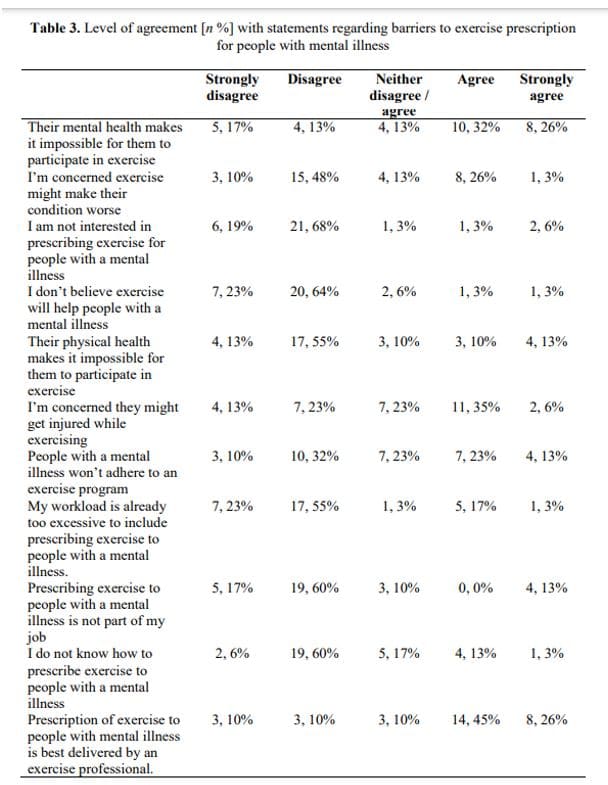
Table 3 shows respondents’ responses to statements about the barriers to exercise prescription for people with mental illness. Those who agreed that patients’ mental health denies them the opportunity to exercise was 58%, while those who agreed that obtaining an injury during exercise is a concern was 45%. There was an overwhelming response by 87% of the respondents who agreed that exercise is beneficial and were interested in prescribing it for patients with mental health problems. However, only 13% agreed that prescribing exercise falls outside their job description. Nonetheless, 16% stated that they did not know how to prescribe exercise for the population. Overall, 71% approved that exercise professionals are best suited to prescribe exercise for people in the population.
Possible Uses of Block Quotations for Writing a Good Commentary Essay
When writing a commentary essay, students can use block quotations to organize comments. However, this feature is suitable mainly for extensive passages. In a simple definition, a block quote is a text that captures direct quotations longer than 40 words, which the writer offsets from the main text and does not include quotation marks. The text appears on a new line with a 0.5 inches indentation or five to seven spaces. Using single space for a block quote is standard, even in an essay requiring double spacing. Hence, students must know how to format block quotes in APA , MLA , Harvard , and Chicago/Turabian referencing styles when writing a commentary essay.
📕 APA Format
There are two ways in which students can write block quotes in the APA style when organizing their commentary essays.
I. The first block captures the author’s name before the quote:
In their tabulation of results, Vancampfort et al. (2019) showed:
Almost 75% of the respondents indicated that they would “definitely” attend further training for exercise prescription for people with mental illness, in particular related to how to assess patients and how to motivate them towards an active lifestyle. More than seventy percent of the participants also reported that exercise to people with mental illness is actually best delivered by an exercise professional, although only one respondent referred patients to such an exercise professional (p. 2178).
“[Your comments on a block quote starts here]”
II. Alternatively, a block quote can have the author’s surname at the end:
According to the findings:
Almost 75% of the respondents indicated that they would “definitely” attend further training for exercise prescription for people with mental illness, in particular related to how to assess patients and how to motivate them towards an active lifestyle. More than seventy percent of the participants also reported that exercise to people with mental illness is actually best delivered by an exercise professional, although only one respondent referred patients to such an exercise professional (Vancampfort et al., 2019, p. 2178).
📕 MLA Format
Similarly, the MLA style has two ways of formatting a block quote when organizing commentary essays.
I. Having the surname of the author preceding a block quote in an essay:
The results by Vancampfort et al. indicate:
Almost 75% of the respondents indicated that they would “definitely” attend further training for exercise prescription for people with mental illness, in particular related to how to assess patients and how to motivate them towards an active lifestyle. More than seventy percent of the participants also reported that exercise to people with mental illness is actually best delivered by an exercise professional, although only one respondent referred patients to such an exercise professional (2178).
II. Having the author’s surname at the end of the quote:
Almost 75% of the respondents indicated that they would “definitely” attend further training for exercise prescription for people with mental illness, in particular related to how to assess patients and how to motivate them towards an active lifestyle. More than seventy percent of the participants also reported that exercise to people with mental illness is actually best delivered by an exercise professional, although only one respondent referred patients to such an exercise professional (Vancampfort et al. 2178).
📕 Harvard Format
The Harvard style also has two ways of formatting a block quote when organizing commentary essays.
I. Indicating the author’s surname before a block quote in an essay:
In their findings, Vancampfort et al. (2019) established that:
II. Citing the author’s surname at the end of a block quote:
Almost 75% of the respondents indicated that they would “definitely” attend further training for exercise prescription for people with mental illness, in particular related to how to assess patients and how to motivate them towards an active lifestyle. More than seventy percent of the participants also reported that exercise to people with mental illness is actually best delivered by an exercise professional, although only one respondent referred patients to such an exercise professional (Vancampfort et al. 2019, p. 2178).
📕 Chicago/Turabian Format
The Chicago/Turabian style also has two ways of formatting a block quote when organizing commentary essays.
I. Mentioning the author’s surname before a block quote in an essay:
According to Vancampfort et al.:
Almost 75% of the respondents indicated that they would “definitely” attend further training for exercise prescription for people with mental illness, in particular related to how to assess patients and how to motivate them towards an active lifestyle. More than seventy percent of the participants also reported that exercise to people with mental illness is actually best delivered by an exercise professional, although only one respondent referred patients to such an exercise professional (this passage must be formatted as a footnote). 1
II. Showing the author’s surname in a footnote:
Receive personalized assistance from our writers, ensuring your paper is both original and tailored to your needs.
Key Features of Formatting Block Quotes When Writing a Commentary Essay
Looking at the examples of writing a commentary in an essay above, there are some similarities and differences in formatting block quotes. APA and Harvard are similar because they show the research article’s publication year and the page number of the information the writer cites in their commentary essay. The main difference is the arrangement of these details, including the place of putting comas. On the other hand, the MLA and Chicago/Turabian styles are similar in that they do not show the research article’s publication year. The main difference is that the Chicago/Turabian style uses footnotes to show the author(s) and all the bibliography details at the commentary essay’s end. The MLA style shows only the author’s surname and the page number in the text. In turn, people begin writing their commentaries in the following line after a block quote as a standard paragraph in all the formats.
Easy Sample Topics for Writing a Great Commentary Essay
Students should choose easy essay topics when writing a commentary essay to avoid complicating their tasks. Ideally, a specific topic should indicate a particular source document one is commenting on, such as a text, film, or image. The standard practice is that instructors define essay topics or commemorative speech topics students should write about. However, people can choose other themes they are comfortable with if such instructions do not exist for writing a commentary essay. The best approach to choosing an easy topic is to engage with course content and read widely to generate and incubate ideas. When the time for writing a commentary essay comes, one finds it easy to construct arguments fitting the task. The following are possible commentary essay topics because they suggest analyzing and examining a source from the writer’s perspective.
- In Memory of Amelia Earhart: Sky’s Fearless Lady
- The Central Themes in Harper Lee’s novel “To Kill a Mockingbird”
- “The Great Gatsby” Through Contemporary Lens
- The Rhetorical Stance in Jessica Grose’s “Cleaning: The Final Feminist Frontier”
- The Message in Robert Frost’s Poem “The Road Not Taken”
- Maya Angelou’s Magic in “And Still I Rise”
- Demystifying Mental Disorders Through the Film “Black Swan (2010)”
- The Essence of Margaret Atwood’s “Negotiating With the Dead: A Writer on Writing”
Sample Outline Template for Writing a Commentary Essay
- Title of a commentary essay must be precise to an assigned topic.
- Title must be short, clear, and easily understandable.
- Title must be interesting, catchy, and with relevant keywords.
I. Introduction Section of a Commentary Essay
- College essay introduction must have a hook that interests readers enough to grab their attention and stirs a curiosity to continue reading.
- Introduction must refer to a specific source (text, film, or image) and its author(s).
- Introduction must summarize an assigned source that includes the main characters (if any), themes, or concepts.
- Introduction must have a clear thesis statement that states the writer’s claim.
II. Body Section of a Commentary Essay
Body paragraphs (at least three):
- Each body paragraph of a commentary essay must have a topic sentence that emphasizes a single idea central to the main claim in the thesis statement that the writer will defend in the paragraph.
- Each body paragraph must include evidence from a source under analysis, such as a quote, indicating the character responsible and the context.
- Each body paragraph must give a commentary about the evidence through relevant analysis, linking the information to the idea at the beginning of the paragraph and the claim in the thesis.
- Each body paragraph must end with a closing statement and a bridge sentence to facilitate a logical flow to the next paragraph or section.
III. Conclusion Section of a Commentary Essay
Sum up a commentary essay by:
- Restating the thesis.
- Emphasizing the main ideas of a commentary essay.
- Giving a final remark that confirms the importance of the essay topic.
Example of a Commentary Essay
Commentary Essay’s Title: The Rhetorical Stance in Jessica Grose’s “Cleaning: The Final Feminist Frontier”
I. Example of an Introduction of a Commentary Essay
A woman never rests, not with society constantly demanding her value at every turn. This idea is the message in Jessica Grose’s famous article, “Cleaning: The Final Feminist Frontier.” The author argues that cleaning remains a feature of women’s value in society, despite men’s growing involvement in childcare and cooking. The article also opens with personal accounts and convincing facts, suggesting its credibility as a source of information about the dynamics confronting American women. In her article, Grose communicates her message effectively by adopting a rhetorical stance characterized by emotional appeals.
II. Example of Body Paragraphs of a Commentary Essay
A. commentary on the main idea of the article.
Grose opens the article with a personal story of her and her husband cleaning their house after Hurricane Sandy forced them indoors. She uses the uneven distribution of the cleaning task in her marriage to point out the larger feminist issue of who between a husband and wife should do the job. The article gives three reasons why men shy away from the cleaning task, including the fact that it is women who receive praise for a clean house, the media focuses on men’s growing involvement in childcare and cooking, and it is not fun. According to Grose, even distribution of the cleaning task can happen by creating a task chart that shows who does what on the basis of skill and ability and adopting cleaning gadgets to make cleaning more fun.
Throughout the article, Grose uses sources to appeal to the readers’ ethos and build her argument. Some of the sources she uses to achieve these goals include a study by sociologists Judith Treas and Tsui-o Tai and an article by Matthew Krehbiel, North America Fabric Care Brand Manager for P&G. Citing these sources helps the author to build her credibility in the eyes of readers.
Regarding appeals to logos, Grose mentions statistics and interesting facts that help to enhance the logical progression of ideas central to her argument. To emphasize the uneven distribution of the cleaning task, she says, “My husband and I both work…I do the dishes nine times out of ten, and he barely knows how the washer and dryer work.” Such facts confirm and support the idea that women do more household chores than men. She also cites statistics, showing “55 percent of mothers working full-time in America do some housework daily compared to 18 percent of fathers.” In this respect, the article is factual about the uneven distribution of household chores that disadvantages women. As a result, the personal details and statistics from credible sources help Grose to impress upon the reader how society uses the domestic environment to subjugate women.
The article appeals to the readers’ pathos in the beginning and middle sections, where Grose uses emotionally-charged words and phrases to induce the audience’s sympathy. For example, Grose laments that, while she “was eight months pregnant,” her husband experienced the complexity of fighting “a massively pregnant person.” These words evoke an image in the readers’ mind that portrays women as vulnerable in the domestic space because of natural factors, like high emotions and pregnancy. Indeed, readers may feel sympathetic to Grose and the women who generally live in this social context. Moreover, using words and phrases, like ‘argued,’ ‘sucks,’ ‘be shunned,’ ‘be judged,’ and ‘headachey,’ evokes readers’ negative feelings about cleaning. As such, they are more drawn to sympathize with men and view men as selfish.
III. Example of a Conclusion of a Commentary Essay
Grose takes a rhetorical stand throughout the article to persuade her audience of the unfair distribution of cleaning labor in the domestic space. By referencing credible sources, citing statistics and interesting facts, and portraying women as adversely disadvantaged, Grose effectively appeals to the readers’ ethos, logos, and pathos. This rhetorical stand is critical in communicating how society remains unfair to women in the domestic space despite men’s growing involvement in some household chores like childcare and cooking.
4 Easy Steps for Writing a Commentary Essay
Writing a commentary essay is a technical process that requires students to grasp essential details. For example, these details reflect 4 writing steps: preparation, stage setup, writing a first draft, and wrap-up. Typically, each step’s details of writing a commentary essay reflect the wisdom writers should exhibit when creating any scholarly text.
Step 1: Preparation
Preparation is the first step of writing a commentary essay. As the name suggests, it is when writers take time to create a favorable environment to write their papers. The first task is identifying a single source, where students should select good sources they can analyze easily, including poems, novels, or films. The second task is to create a topic, where students must write short topics that communicate a precise message of a commentary essay.
Step 2: Stage Setup
Setting the stage is the second step of writing a commentary essay. The first task is to read, watch, or examine an assigned source to identify key themes and ideas. The second activity is to research reliable sources that help to generate ideas that align with these themes and concepts. The next task is to create a clear essay outline emphasizing the introduction, body, and conclusion with all the essential details.

Step 3: Writing a First Draft of a Commentary Essay
Writing a first draft is the third step in creating a commentary essay, and the focus is generating a paper that can be used for further editing and improvement. As such, students should organize their ideas into text, emphasizing the claim in the thesis statement, ideas in the topic sentences, evidence (quotes), and transitions in the body paragraphs. Students should also ensure the conclusion restates the thesis, summarizes the main ideas of a commentary essay, and gives a final remark about their commentaries, focusing on an assigned source and topic.
Step 4: Wrap-Up
The wrap-up is the last step in writing a commentary essay. The main focus is transforming a first draft into a final text by eliminating all mistakes and flaws. Typically, students should revise all sections that do not make sense to a central claim or those that affect the paper’s logical progression. They should also edit a commentary essay by adding or deleting words and phrases and eliminating grammatical mistakes, missing punctuation, formatting errors, and incorrect citations.
20 Tips for Writing a Commentary Essay
Looking at the information in the preceding sections, writing a great commentary essay is a complex task that requires students to demonstrate knowledge of what it takes to create a quality paper. Some of the tips for writing a commentary essay include identifying a single source, which can be a text, film, or image; noting the source’s basic information, like the author, title, and publication date; identifying the central themes in the source; writing an introduction that emphasizes the source’s basic information; creating a thesis that communicates a claim about the source; adopting the unique structure as above; beginning paragraphs with a topic sentence; incorporating quotes from the source into body paragraphs; commenting on the quotes and their significance; and concluding a commentary essay with a summary that makes a final remark about a single source and topic.
10 things to do when writing a commentary essay include:
- identifying a source for writing a commentary essay;
- reading, watching, or analyzing an assigned source carefully and closely;
- outlining critical details, like themes, ideas, and literary devices;
- writing an introduction with a hook and an argumentative thesis statement;
- providing body paragraphs with topic sentences, concluding sentences, quotes, commentary, and transitions;
- maintaining a formal tone in a commentary essay;
- using the applicable format (APA, MLA, Harvard, or Chicago/Turabian) correctly;
- presenting an introduction that summarizes a commentary essay;
- avoiding grammatical mistakes;
- proofreading a final version of a commentary essay.
10 things not to do include:
- failing to document the source’s essential details, like the author’s name and surname;
- concentrating on the introduction more than the body;
- not incorporating quotes in body paragraphs;
- focusing on too many ideas in a commentary essay;
- not defending the claim in the thesis;
- ignoring a unique outline of a commentary essay;
- writing with too many grammatical mistakes;
- using different formatting styles (APA, MLA, Harvard, and Chicago/Turabian);
- not implementing transitions in body paragraphs;
- creating a commentary essay without a logical flow of ideas and thoughts.
Summing Up on How to Write a Perfect Commentary Essay
- Choose a single source that is simple to analyze.
- Create a clear thesis that emphasizes the focus of a commentary essay, such as a claim.
- Identify passages or themes in an assigned source that help to build an argumentative claim.
- Use an introduction paragraph for its purpose: to introduce a specific topic. As such, it should be short and precise.
- Use a body section for its purpose: to analyze a particular source and defend a central claim comprehensively. Therefore, it should be long and have quotes as evidence.
- Use a conclusion part to summarize a commentary essay, and it should be concise. More importantly, it should leave readers with a lasting impression of a defined source and topic.
To Learn More, Read Relevant Articles
Reducing plastic waste in the ocean: an innovative approach, history of cryptography and its modern applications.

Oxford Tutoring
We Teach the Way you Learn!

Elements of an Essay: Writing Commentary
For several weeks now, we have been identifying the essential elements of essays and learning how to incorporate these effectively and successfully. We have discussed that the thesis statement is the glue that holds the entire paper together, the body paragraphs are the meat where the majority of your argument will be found, and last week we looked at how the details are the key to unlocking your argument . Today we are going to take a look at the other extremely important factor in writing a well-thought out essay. It is needed for every single detail that you write. It is the commentary.
Commentary Definition
When you write commentary, you are explaining to your reader how the details relate to the thesis statement. Commentary does not contain facts. Instead, they help explain why the details are relevant to the topic.
Writing Commentary

You are going to need at least two sentences of commentary for every detail sentence. A good rule of thumb is that your commentary should be twice as long as your details. Otherwise, your paper is just full of facts. We want to know how YOU think these facts prove your point and what YOU think they mean.
Here are a few different methods for writing commentary:
1) Opinion: this is where you write your belief, subjective judgment or way of thinking about a detail .
2) Interpretation: your explanation of something that is not clear.
3) Character and Subject’s Feelings: when you describe what the character or subject of the detail is feeling (ideal for literary analysis papers)
4) Personal Reaction: your personal emotions about the detail.
5) Evaluations: your objective judgment of a detail.
Commentary is the Treasure
Your commentary is the treasure that makes your paper shine. It should always strengthen and extend the details. This is your chance to show us what you’ve got. It is where you can impress us with your analysis and interpretation skills.
“What and Why” Method
You may be thinking, “Analysis and interpretation skills? What if I don’t possess those skills?” Well breathe easy, because interpretation is really just a fancy word for “what,” while analysis simply means “why”.
So if you are struggling to write your commentary try using the “what and why” method. First, tell the reader WHAT your detail is talking about by defining or explaining. Next, let your reader know WHY this detail is relevant to your thesis statement.
Starting Commentary Sentences
If you are struggling to start your commentary, consider beginning your commentary in one of the following ways:
“This shows that…”
“This is important because…”
Obviously, you cannot start every sentence you write like that since this would be redundant. However, even if you do not write these phrases at the beginning of all of your sentences, it is helpful even just to think these phrases in order to guide your commentary in the right direction.
Applying Commentary Techniques
Now that we have discussed the different options for writing commentary, and the method for doing so, let’s put them together and see what is looks like.
Commentary Type: Opinion using the “what and why” method

Topic: education
Detail: According to the 2013 National Assessment of Education Progress Reading test, 80% of students score below grade level in reading.
Commentary: Your commentary for this detail will answer the following questions: (1) “WHAT is my opinion?” and (2) “WHY is my opinion relevant to my thesis statement?”
(1) A statistic like this shows the poor state of the education. (2) If we are to help students become successful adults, we need to change the way we are educating our children.
Commentary Type: Interpretation using the “what and why” method
Topic: benefits of college
Detail: First of all, of 2,350,000 college students enrolling per year, only 1,750,000 will graduate.
Commentary: Your commentary for this detail will answer the following questions: (1) “WHAT is my interpretation?” and (2) “WHY is my interpretation relevant to my thesis statement?”
(1) This shows that the high demand placed on students during their college years is too much stress for many. (2) However rigorous it may be though, the pressure and expectations are reflective of a future career and help prepare young adults for these challenges.
Commentary Type: Character or Subject Feelings using the “what and why” method

Topic: cost of higher education
Detail: For example, Benjamin Davis, a recent college graduate with a degree in Business, struggled for many years to find a job because of the recent unemployment struggles in America
Commentary: Your commentary for this detail will answer the following questions: (1) “WHAT is the subject’s feelings?” and (2) “WHY is subjects feelings relevant to my thesis statement?”
(1) He, like most, experiences extreme frustration at spending a great deal of time and money obtaining his degree, but feeling like he has very little advantage over others without a degree when finding a job. (2) As a result, many who find themselves in a similar situation are left wondering if higher education is worth the high cost.
Commentary Type: Personal Reaction using the “what and why” method
Topic: bullying
Detail: Also, a bully might speak cruelly in order to intimidate, steal a student’s belongings, or intentionally exclude one from a group .
Commentary: Your commentary for this detail will answer the following questions: (1) “WHAT is my personal reaction?” and (2) “WHY is my personal reaction relevant to my thesis statement?”
(1) It is extremely upsetting to know that most children undergo this type of treatment at school. (2) It is hurtful, isolating, and can have long-lasting psychological damage on those students who experience bullying often.
Commentary Type: Evaluation using the “what and why” method
Topic: bears
Detail: Naturally, a bear, when threatened, will rise up from the ground, growl loudly, and begin charging at a speed of up to 35 mph.
Commentary: Your commentary for this detail will answer the following questions: (1) “WHAT is my evaluation?” and (2) “WHY is my evaluation relevant to my thesis statement?”
(1) Although this is a frightening experience, it is not entirely the bear’s fault. (2) In fact, most of the time when a bear attacks a person, it is the result of a person not understanding that when going out into the woods, he or she is entering a bear’s environment; forgetting to be respectful and cautious can cause the bear to react thusly.
When To Use Commentary Types
Depending on your assignment, choose the types of commentary that best fits your argument. Use of a variety of different types of commentary to write a well-argued paper.

Go back and look at step two of writing details from last week’s blog. Look at the commentary you wrote and update it to fit into the “what and why” method using some of the above types of commentary. If you did not do that step last week, go ahead and use the worksheet found here.
We hope this helped you when writing commentary. If you still need help, call Oxford Tutoring for support or to schedule a writing tutoring session.
Share this:
Author: oxfordtutoringblog
Oxford Tutoring specializes in K-12 tutoring in English, mathematics, science and test preparation. We provide skill building and homework help in private, one-on-one sessions coordinated with our student’s classroom programs, but focused on the way in which each student learns. Working to better each student’s academic success, Oxford Tutoring personalizes our tutoring approach to best meet the education needs of our students. View All Posts
One thought on “ Elements of an Essay: Writing Commentary ”
- Pingback: Elements of an Essay: Editing and Revising – Oxford Tutoring
Leave a comment Cancel reply

- Already have a WordPress.com account? Log in now.
- Subscribe Subscribed
- Copy shortlink
- Report this content
- View post in Reader
- Manage subscriptions
- Collapse this bar

- Walden University
- Faculty Portal
Common Assignments: Commentary Versus Opinion
Commentary and argumentation.
In order to synthesize your sources, you must first analyze them to help provide rationale for why they are a part of your literature review and what role they play within your field. In order to demonstrate analysis, you must provide your commentary on the sources you discuss beyond simply summarizing them.
Consider the following, analysis-free excerpt. This approach is typical in first drafts of literature reviews:
....is to deny the student (Sigree, 1999). As Harper (2001) noted, instructors cannot identify every one of their students' emotional intelligences (EI). Faculty members do not have the time, and students simply are not that forthcoming with their learning preferences (Harper, 2001). Furthermore, as Harper warned, if instructors decide to attempt a complete analysis of every student's EI, they will inevitably hold the entire class back. After all, taking time to adequately diagnose a student's EI means less time for helping students meet the expectations set forth by the No Child Left Behind Act (Harper, 2001). Finkelstein and Kramer's (2002) findings…
There is no analysis or critique in this excerpt. There is strong paraphrasing, and this passage provides a decent overview of Harper, but it addresses only Harper's ideas and does not explain why this information is important and how it relates to the author's overall purpose for the paper. The reader needs to know the answer to "So what, and who cares?"
What is missing from this summary is context and analysis. Consider the following revision:
....is to deny the student (Sigree, 1999). Harper (2001), however, disagreed with Sigree's (1999) assertion. Harper noted that despite the obvious benefits of diagnosing a student's emotional intelligence (EI; Jones & Hammer, 1998; Mooney, 1998; Sigree, 1999), instructors cannot identify every one of their students' EIs (Harper, 2001). Faculty members do not have the time, and students are not that forthcoming with their learning preferences (Harper, 2001). For Harper (2001), though, the real issue was not with instructors' belief in EI, but rather in how this belief affected classroom logistics. Instructors who follow Earnhart's (1996) advice to "Take the time to understand how each of your students learn" (p. 33) are being impractical, Harper argued. Taking time to adequately diagnose a student's EI means less time for helping students meet the expectations set forth by the No Child Left Behind Act (Harper, 2001). Although Earnhart's (1996) vision is ideal, Harper takes a more practical stance. With Harper's (2001) concerns in mind, I cannot endorse Finkelstein and Kramer’s (2002) findings…
Here, the author is synthesizing the literature. We know, based on the author's direction, how Harper interacts with the other literature on the topic. We know that Harper is probably in the minority, and we know what the author's take on Harper is. Finally, we know how and why the author is using Harper: Harper will be used to refute Finkelstein and Kramer, which presumably is the author's intent or thesis. Notice how the author demonstrated analysis and synthesis in just a few additional sentences.
Related Resource
Didn't find what you need? Search our website or email us .
Read our website accessibility and accommodation statement .
- Previous Page: Synthesizing Your Sources
- Next Page: Literature Review Matrix
- Office of Student Disability Services
Walden Resources
Departments.
- Academic Residencies
- Academic Skills
- Career Planning and Development
- Customer Care Team
- Field Experience
- Military Services
- Student Success Advising
- Writing Skills
Centers and Offices
- Center for Social Change
- Office of Academic Support and Instructional Services
- Office of Degree Acceleration
- Office of Research and Doctoral Services
- Office of Student Affairs
Student Resources
- Doctoral Writing Assessment
- Form & Style Review
- Quick Answers
- ScholarWorks
- SKIL Courses and Workshops
- Walden Bookstore
- Walden Catalog & Student Handbook
- Student Safety/Title IX
- Legal & Consumer Information
- Website Terms and Conditions
- Cookie Policy
- Accessibility
- Accreditation
- State Authorization
- Net Price Calculator
- Contact Walden
Walden University is a member of Adtalem Global Education, Inc. www.adtalem.com Walden University is certified to operate by SCHEV © 2024 Walden University LLC. All rights reserved.
An official website of the United States government
The .gov means it’s official. Federal government websites often end in .gov or .mil. Before sharing sensitive information, make sure you’re on a federal government site.
The site is secure. The https:// ensures that you are connecting to the official website and that any information you provide is encrypted and transmitted securely.
- Publications
- Account settings
Preview improvements coming to the PMC website in October 2024. Learn More or Try it out now .
- Advanced Search
- Journal List
- Int J Qual Stud Health Well-being
Guidelines for writing a commentary
A commentary is a comment on a newly published article. A commentary may be invited by the chief editor or spontaneously submitted. Commentaries in International Journal of Qualitative Studies on Health and Well-being are peer reviewed. We now welcome commentaries!
What is a commentary?
The goal of publishing commentaries is to advance the research field by providing a forum for varying perspectives on a certain topic under consideration in the journal. The author of a commentary probably has in-depth knowledge of the topic and is eager to present a new and/or unique viewpoint on existing problems, fundamental concepts, or prevalent notions, or wants to discuss the implications of a newly implemented innovation. A commentary may also draw attention to current advances and speculate on future directions of a certain topic, and may include original data as well as state a personal opinion. While a commentary may be critical of an article published in the journal, it is important to maintain a respectful tone that is critical of ideas or conclusions but not of authors.
In summary, a commentary may be:
- A critical challenge to one or more aspects of the focal article, arguing for a position other than that taken in the focal article.
- An elaboration or extension of the position taken in the focal article, basically sympathetic to the position taken in the focal article but pushing the argument further.
- An application of a theoretical or methodological perspective that sheds light on the issues addressed in the focal article.
- A reflection on the writer's experiences in applying the issues addressed in the focal article, in particular health and well-being settings.
- A comment on the applicability of the issues raised in the focal article to other settings, or to other cultures.
How to write a commentary
Commentaries in International Journal of Qualitative Studies on Health and Well-being should not exceed 10 manuscript pages. A tightly argued four- to six-page commentary is likely to be better received than a meandering 10-page ditto. Use these simple guidelines:
- Do not summarize the focal article; just give the reference. Assume the reader has just read it. Move directly to identifying the key issues you want to raise.
- Do not include general praise for the focal article.
- Use only essential citations. For commentary purposes, cite only works absolutely essential to support your point.
- Use a short title that emphasizes your key message. (It should be clear in context that all commentaries are a reaction to a particular paper).
- Do not include an abstract.
- Make clear your take-home message.
- Make sure there is full author information (name, affiliation, address, phone, email) for all authors. Authors must be individuals.
Review process
Commentaries will be peer reviewed and most likely accepted if they are in line with the definitions and guidelines outlined. A small set of reviewers will read and evaluate all commentaries as they need to compare commentaries for issues of redundancy and to make evaluations of relative merit.
Queries for the editor
Authors should feel free to correspond with the chief editor prior to submitting a commentary if there are questions about any aspect of the evaluation and publication process. Authors may prepare a brief outline of the key points they desire to present in the commentary and send it to the chief editor.
Does it cost anything to submit a commentary?
Spontaneously submitted commentaries incur a cost of €65 per typeset page. The author will be invoiced once the commentary has been accepted for publication.
We hope you will send us a commentary whenever you think there is a need to broaden the perspectives on health and well-being presented in our journal.
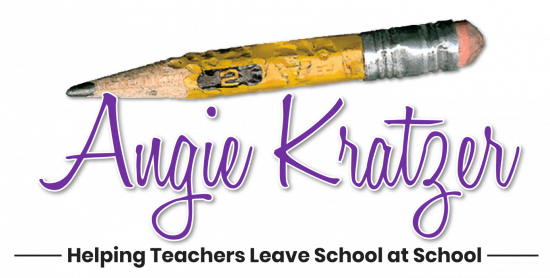
The Role of Commentary in Rhetorical Analysis
Call it what you will—analysis, evaluation, commentary—this piece of rhetorical analysis is OPINION. Evidence is FACT, and commentary is OPINION. (When I’m training students to recognize the difference between the two, we use color coding. You can read more about how I do that here. )
Where students get tripped up is in misunderstanding the actual role of commentary; perhaps they see it as filler or some kind of semi-important text that is loosely associated with nearby evidence. If the latter is the case, they’re in the ballpark, so let’s get those writers into an actual seat. For the purpose of this post, we’ll talk specifically about rhetorical analysis since so many teachers begin with that skill set.
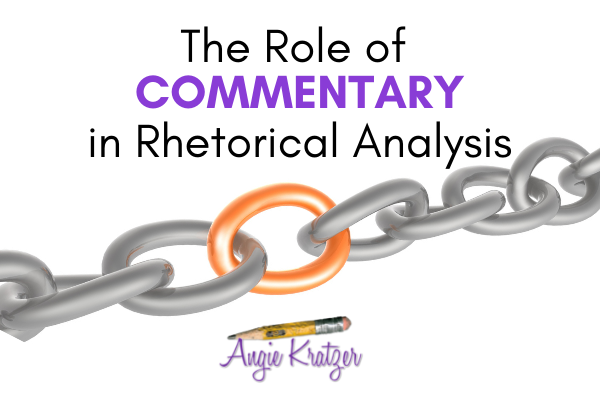
Commentary’s Jobs in Rhetorical Analysis
Job #1: make connections.
I made this super short video to explain visually what you’ll read below.
WHAT IS COMMENTARY? VIDEO (TWO MINUTES)
Analysis—what we’re calling commentary—is the student’s opinion about the way evidence proves the truth of a topic sentence, which defends the truth of the controlling thesis statement. Here’s how the connecting works. A rhetorical analysis essay has a thesis, which is a controlling idea. All ideas within the essay defend this one. If an idea does not defend this one, it has to go. I call that trimming the fat.
On the front lines of the defense of that thesis are the topic sentences. For a timed essay, we’re probably looking at two or three of those. Each of those topic sentences is a debatable idea that must also be defended. What defends each topic sentence is evidence, factual information taken from the text. Evidence defends the topic sentence, which defends the thesis. Here we go: The job of commentary is to tie the evidence to the topic sentence. This is where the student offers OPINION about how the factual evidence illustrates the truth of the topic sentence.
By connecting the evidence to the topic sentence and the topic sentence to the thesis, the commentary defends the thesis. This chain of defense is the way I wrap my mind around line of reasoning.
Done well, it’s beautiful. Done poorly, it looks like A LOT what we see in student essays.
J ob #2: Illustrate Critical Thinking
Commentary separates the men from boys, the wheat from the chaff, the analogies from the metaphors. Every writing rubric I’ve ever seen rewards it heavily.
On the AP Language Question 2 rubric, take a look at this wording for the column that awards all four points for evidence and commentary:
EVIDENCE: Provides specific evidence to support all claims in a line of reasoning. AND COMMENTARY: Consistently explains how the evidence supports a line of reasoning. AND Explains how multiple rhetorical choices in the passage contribute to the writer’s argument, purpose, or message.
That’s THIS illustration! There are only four points to be had on this rubric, and FOUR of them are awarded to the process I described in that short little video above.
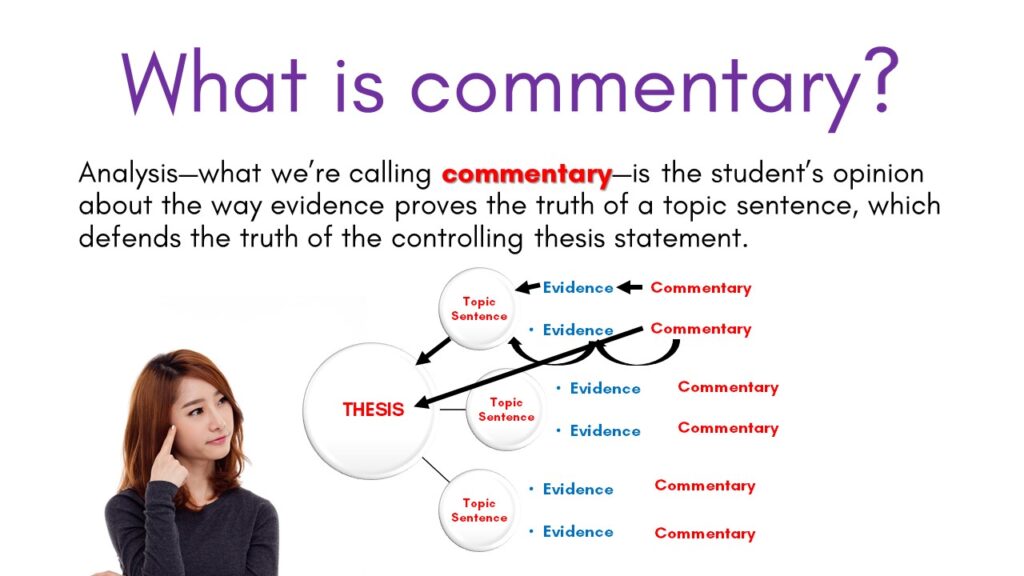
A student who creates that defense chain consistently with depth could even earn the sophistication point. That’s five out of six. Without a defensible thesis, that student could never have earned the four points for evidence and commentary because there was nothing to defend. That’s six out of six.
Translation: A student who understands the defense chain of a topic sentence being defended by topic sentences that are supported by evidence with connecting commentary is in the five-six range because that student’s maturity of thought is on full display to a reader.
What Commentary’s Role is NOT
Commentary’s job is not to provide proof from the text, either through direct quotations, paraphrasing, summarizing, or repetition of the actual evidence. When training students to write strong commentary, I suggest that we put off sentence combining; have students differentiate evidence from commentary through color coding so that both you and they can see that each piece of evidence has a tendon, a connector that ties the evidence to the topic sentence.
Once kids know what commentary is and isn’t–and all their English teachers communicate so they’re all using the same terminology–they can produce insightful, connected analysis.
Be on the lookout for more rhetorical analysis tips in your inbox. not on my email list you can join here, and i’ll send you a commentary anchor chart..
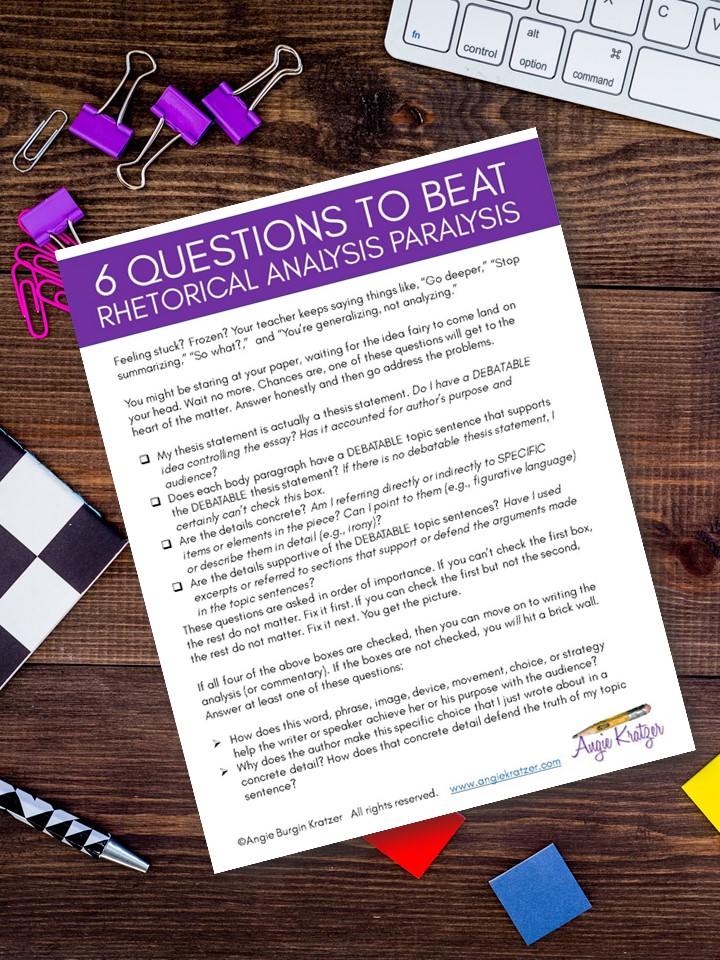
I’m a recovering high school English teacher and curriculum specialist with a passion for helping teachers leave school at school. I create engaging, rigorous curriculum resources for secondary ELA professionals, and I facilitate workshops to help those teachers implement the materials effectively.
- AP Language Exam
- Argumentation & Persuasion
- Grammar & Usage
- Reading Instruction
- Rhetorical Analysis
- Teacher Tips & Best Practices
- The Research Process
- Uncategorized
- Writing Instruction
Copyright © 2023 Angie Kratzer Site Design by Laine Sutherland Designs
Privacy Overview
AP ® Lang teachers: looking to help your students improve their rhetorical analysis essays?
Coach Hall Writes
clear, concise rhetorical analysis instruction.
How to Write Commentary for Rhetorical Analysis
February 4, 2022 by Beth Hall
Wondering how to write commentary for rhetorical analysis? When writing a rhetorical analysis essay, having well thought out and strong commentary will make a significant difference in your writing.
So, what exactly is commentary? And how can you deliver high-quality commentary in your rhetorical analysis?
Commentary is your analysis and interpretation of the passage. Commentary explains how the evidence you present in the body paragraph proves your thesis. For more information about what commentary is, click here .
Your body paragraphs in your rhetorical analysis will consist of a topic sentence, analysis, and commentary. Many students think evidence is the most important piece, and while evidence is certainly important, commentary is paramount because it is what contains your argument and analysis. You can think of your evidence as answering the “what” and commentary answering the “how” or “why.”
In order to effectively write commentary in your body paragraphs, you need to have an understanding of the rhetorical situation. The rhetorical situation includes the following elements: the writer or speaker, the audience, the (historical) context, the exigence (ie. what prompted the writer to write), the purpose, and the message or argument.
The rhetorical situation is key to your commentary because it is what you are analyzing. Your commentary should address why the rhetorical choice the author is making is important to the rhetorical situation. (You can learn more about the rhetorical situation by reading this blog.)
How to Develop Your Commentary
Many students don’t develop their commentary enough because they aren’t sure what to say, or they feel they are running out of time.
When writing a rhetorical analysis essay, be sure to include precise verbs to convey what the writer is “doing.”
Here’s a list of rhetorically accurate verbs:
- Acknowledges
Once you’ve made a claim about what the writing is “doing” (the rhetorical choice they are making,) then you need to explain the significance of that choice. Why is the writer “doing” that? This is commentary.
Here are some verbs that can help you generate commentary:
- demonstrates
- illustrates
- underscores
The step to knowing how to write commentary for rhetorical analysis is knowing the right kinds of questions to ask. When you are addressing the rhetorical situation, you want to do more than scratch the surface level. Let’s look at examining the writer or speaker, for example. You may ask some of the following questions to help you create commentary about the rhetorical choice you are analyzing:
- What are the speaker’s qualifications?
- What does the choice reveal about the speaker’s beliefs/values/needs?
- What do the choices reveal about the speaker’s relationship with the audience?
If you want more questions to guide you on analyzing the rhetorical situation, check out this blog.
How do I write a body paragraph with commentary?
Now that you know the parts that make up the commentary, and you understand how to examine the rhetorical situation, let’s put it all together. Let’s look at an excerpt of a body paragraph, and notice how commentary is used.
Albright references recent political examples in which countries could have settled but chose the more arduous path instead. By noting that America “must choose to turn inward” or “seize opportunities,” Albright suggests the value of making challenging, sometimes “trailblazing” decisions as opposed to selecting the easier, more isolating path . While this comment also serves as affirmation of President Clinton’s leadership and thus a subtle reminder of Albright’s credentials as Secretary of State , the contrast between “turning inward” and “seizing opportunities” introduces Albright’s message of perseverance.
In just this small excerpt, you can see how different elements (underlined) of the rhetorical situation are being addressed. When you are writing your own body paragraphs, it may be helpful to color-code the different elements of the rhetorical situation and identify them in your writing. This will help you check to make sure most of the elements are present.
How do you fix limited commentary?
If you find yourself writing with cliches, idioms, vague wording, or sentences that don’t directly address the rhetorical situation, you are likely writing limited commentary. You want each sentence to address your specific passage, so aim to create specific, clear analysis.
Here is what your writing may look like if you have limited commentary:
- You use phrases like “the author uses diction”
- You use cliches like “opens the reader’s eyes”
- You use idioms like “touches the audience’s heart”
This type of writing is common and also fixable. Once you’ve identified these mistakes in your writing, you want to work on changing them.
First, you can fix phrases such as “the author uses” by strengthening your word choice. You want to add a descriptor or adjective in front of the item you are referring to, such as diction. This might mean changing “diction” to “patriotic diction.” Then, analyze why the author uses this rhetorical choice.
Second, you want to avoid cliches. Try rewording the cliche. Instead of “opens the reader’s eyes” try “forces the reader to consider.” This makes our language more precise and helps you expand your commentary.
Lastly, you want to stay away from idioms. These prepackaged expressions don’t tell the reader the why and the how behind the author’s writing choices. Instead of saying “touches the audience’s heart” try to identify what the writer is doing to evoke that emotional response. Specify which emotion the audience is experiencing and why the writer wants to elicit such an emotion.
Now that you know how to write commentary for rhetorical analysis, go rock your next AP® Lang essay!
DISCLAIMER: I am not affiliated with The College Board. The advice and opinions expressed in this blog post are my own.
AP® Lang Teachers
Looking to help your students improve their rhetorical analysis essays?
Latest on Instagram

Shop My TPT Store
Have a language expert improve your writing
Run a free plagiarism check in 10 minutes, generate accurate citations for free.
- Knowledge Base
- How to write an essay outline | Guidelines & examples
How to Write an Essay Outline | Guidelines & Examples
Published on August 14, 2020 by Jack Caulfield . Revised on July 23, 2023.
An essay outline is a way of planning the structure of your essay before you start writing. It involves writing quick summary sentences or phrases for every point you will cover in each paragraph , giving you a picture of how your argument will unfold.
Instantly correct all language mistakes in your text
Upload your document to correct all your mistakes in minutes

Table of contents
Organizing your material, presentation of the outline, examples of essay outlines, other interesting articles, frequently asked questions about essay outlines.
At the stage where you’re writing an essay outline, your ideas are probably still not fully formed. You should know your topic and have already done some preliminary research to find relevant sources , but now you need to shape your ideas into a structured argument.
Creating categories
Look over any information, quotes and ideas you’ve noted down from your research and consider the central point you want to make in the essay—this will be the basis of your thesis statement . Once you have an idea of your overall argument, you can begin to organize your material in a way that serves that argument.
Try to arrange your material into categories related to different aspects of your argument. If you’re writing about a literary text, you might group your ideas into themes; in a history essay, it might be several key trends or turning points from the period you’re discussing.
Three main themes or subjects is a common structure for essays. Depending on the length of the essay, you could split the themes into three body paragraphs, or three longer sections with several paragraphs covering each theme.
As you create the outline, look critically at your categories and points: Are any of them irrelevant or redundant? Make sure every topic you cover is clearly related to your thesis statement.
Order of information
When you have your material organized into several categories, consider what order they should appear in.
Your essay will always begin and end with an introduction and conclusion , but the organization of the body is up to you.
Consider these questions to order your material:
- Is there an obvious starting point for your argument?
- Is there one subject that provides an easy transition into another?
- Do some points need to be set up by discussing other points first?
Here's why students love Scribbr's proofreading services
Discover proofreading & editing
Within each paragraph, you’ll discuss a single idea related to your overall topic or argument, using several points of evidence or analysis to do so.
In your outline, you present these points as a few short numbered sentences or phrases.They can be split into sub-points when more detail is needed.
The template below shows how you might structure an outline for a five-paragraph essay.
- Thesis statement
- First piece of evidence
- Second piece of evidence
- Summary/synthesis
- Importance of topic
- Strong closing statement
You can choose whether to write your outline in full sentences or short phrases. Be consistent in your choice; don’t randomly write some points as full sentences and others as short phrases.
Examples of outlines for different types of essays are presented below: an argumentative, expository, and literary analysis essay.
Argumentative essay outline
This outline is for a short argumentative essay evaluating the internet’s impact on education. It uses short phrases to summarize each point.
Its body is split into three paragraphs, each presenting arguments about a different aspect of the internet’s effects on education.
- Importance of the internet
- Concerns about internet use
- Thesis statement: Internet use a net positive
- Data exploring this effect
- Analysis indicating it is overstated
- Students’ reading levels over time
- Why this data is questionable
- Video media
- Interactive media
- Speed and simplicity of online research
- Questions about reliability (transitioning into next topic)
- Evidence indicating its ubiquity
- Claims that it discourages engagement with academic writing
- Evidence that Wikipedia warns students not to cite it
- Argument that it introduces students to citation
- Summary of key points
- Value of digital education for students
- Need for optimism to embrace advantages of the internet
Expository essay outline
This is the outline for an expository essay describing how the invention of the printing press affected life and politics in Europe.
The paragraphs are still summarized in short phrases here, but individual points are described with full sentences.
- Claim that the printing press marks the end of the Middle Ages.
- Provide background on the low levels of literacy before the printing press.
- Present the thesis statement: The invention of the printing press increased circulation of information in Europe, paving the way for the Reformation.
- Discuss the very high levels of illiteracy in medieval Europe.
- Describe how literacy and thus knowledge and education were mainly the domain of religious and political elites.
- Indicate how this discouraged political and religious change.
- Describe the invention of the printing press in 1440 by Johannes Gutenberg.
- Show the implications of the new technology for book production.
- Describe the rapid spread of the technology and the printing of the Gutenberg Bible.
- Link to the Reformation.
- Discuss the trend for translating the Bible into vernacular languages during the years following the printing press’s invention.
- Describe Luther’s own translation of the Bible during the Reformation.
- Sketch out the large-scale effects the Reformation would have on religion and politics.
- Summarize the history described.
- Stress the significance of the printing press to the events of this period.
Literary analysis essay outline
The literary analysis essay outlined below discusses the role of theater in Jane Austen’s novel Mansfield Park .
The body of the essay is divided into three different themes, each of which is explored through examples from the book.
- Describe the theatricality of Austen’s works
- Outline the role theater plays in Mansfield Park
- Introduce the research question : How does Austen use theater to express the characters’ morality in Mansfield Park ?
- Discuss Austen’s depiction of the performance at the end of the first volume
- Discuss how Sir Bertram reacts to the acting scheme
- Introduce Austen’s use of stage direction–like details during dialogue
- Explore how these are deployed to show the characters’ self-absorption
- Discuss Austen’s description of Maria and Julia’s relationship as polite but affectionless
- Compare Mrs. Norris’s self-conceit as charitable despite her idleness
- Summarize the three themes: The acting scheme, stage directions, and the performance of morals
- Answer the research question
- Indicate areas for further study
If you want to know more about AI tools , college essays , or fallacies make sure to check out some of our other articles with explanations and examples or go directly to our tools!
- Ad hominem fallacy
- Post hoc fallacy
- Appeal to authority fallacy
- False cause fallacy
- Sunk cost fallacy
College essays
- Choosing Essay Topic
- Write a College Essay
- Write a Diversity Essay
- College Essay Format & Structure
- Comparing and Contrasting in an Essay
(AI) Tools
- Grammar Checker
- Paraphrasing Tool
- Text Summarizer
- AI Detector
- Plagiarism Checker
- Citation Generator
Prevent plagiarism. Run a free check.
You will sometimes be asked to hand in an essay outline before you start writing your essay . Your supervisor wants to see that you have a clear idea of your structure so that writing will go smoothly.
Even when you do not have to hand it in, writing an essay outline is an important part of the writing process . It’s a good idea to write one (as informally as you like) to clarify your structure for yourself whenever you are working on an essay.
If you have to hand in your essay outline , you may be given specific guidelines stating whether you have to use full sentences. If you’re not sure, ask your supervisor.
When writing an essay outline for yourself, the choice is yours. Some students find it helpful to write out their ideas in full sentences, while others prefer to summarize them in short phrases.
You should try to follow your outline as you write your essay . However, if your ideas change or it becomes clear that your structure could be better, it’s okay to depart from your essay outline . Just make sure you know why you’re doing so.
Cite this Scribbr article
If you want to cite this source, you can copy and paste the citation or click the “Cite this Scribbr article” button to automatically add the citation to our free Citation Generator.
Caulfield, J. (2023, July 23). How to Write an Essay Outline | Guidelines & Examples. Scribbr. Retrieved April 5, 2024, from https://www.scribbr.com/academic-essay/essay-outline/
Is this article helpful?

Jack Caulfield
Other students also liked, how to create a structured research paper outline | example, a step-by-step guide to the writing process, how to write an argumentative essay | examples & tips, "i thought ai proofreading was useless but..".
I've been using Scribbr for years now and I know it's a service that won't disappoint. It does a good job spotting mistakes”

Perspective, Opinion, and Commentary Pieces
It is important for researchers to decide the type of research article they are going to write and publish. The paper you write will depend mainly on the type of study conducted. It will also depend on the intended audience and the guidelines from the journal to which the work will be submitted.
The objective of any research is to add to the existing knowledge in the field of study. The paper must thus present research and results in a clear and concise manner. It also ensures that your paper is comprehensible and other researchers, who may want to reproduce your results, are able to do so. You can also contribute to your field of interest by sharing your expertise or views in the form of a review of a research area or a related policy. Several formats allow you to provide your personal take on many topics that influence your field of interest. We present here a description of three such formats—perspective, opinion, and commentary—to help you decide which type fit with your intended audience and outcome.
Perspective Pieces
A perspective “piece” is a personal opinion in writing that is a review of a certain topic. Usually, these are short essays that are intended to review concepts in a particular field based on writer’s own assessment. For instance, Nature often publishes peer-reviewed essays that discuss research models and concepts to help raise awareness of new ideas in the field and develop new study methods.
Perspective pieces also provide information on key findings and the latest developments in that discipline. The writers (often more than one) are experts in their field of study and discuss the latest research and its implications. They also provide highlights from relevant conferences and seminars. These pieces include an abstract, reference list, and figures (if necessary).
When considering writing a perspective piece, make sure that the reviews are of concepts and not of the research studies and focused on the message you want to convey. These essays can be anywhere from 2,000 to 5,000 words depending on the journal.
Opinion Pieces
An opinion piece is a short article that conveys the author’s viewpoint on a research study. It presents a personal review of, for example, the methods and analyses done in the study. It also provides the author’s viewpoint on the researcher’s hypothesis and its shortcomings (if any). These pieces are meant to provide constructive criticism. Although they are personal observations, evidence should be available to support the author’s critique of the study.
Some journals consider and welcome opinions from readers as short correspondence. In some cases, the editors will solicit a longer opinion piece to publish it as an article. Although reader’s comments are accepted, unsolicited opinion articles are not. Moreover, some journals refer to opinion pieces as short editorials. They invite these editorials from the readers and encourage discussion on an issue that is critical to research community. Most opinion pieces or editorials are no more than 1,000 words, with no abstract and no more than five references. Tables and figures are usually not part of these pieces.
Commentaries
A commentary is a more in-depth analysis written to draw attention to a work already published. Commentaries are somewhat like “reviews” in that the author presents his or her analysis of a work and why it would be of interest to a specific audience. Depending on the journal, commentaries can differ in scope and length from 1500 to 3000 words . Some journals may have req uirements that are more specific. They may expect writers to analyze other subjects, such as funding, political issues, and career opportunities, that would be of interest to those in that research area. Most commentaries are subject to formal peer review.
Which Should You Chose?
Which format is best for you depends on a few factors to consider. Who is your audience? What do you hope to accomplish? Were you commissioned to write the piece?
If you wish to submit an unsolicited piece, you must remember that journal submission rules vary. Some journals do not accept any such pieces and others will publish only those that are peer reviewed.
It can be to your advantage to offer to write any of these papers. As a researcher, your opinion should matter to your colleagues, especially if you have already published original research. In addition, if you are commissioned or solicited by the editors of a particular journal to write a piece, it validates your expertise and respect from those within your field of study and can help further your career.
Several journals provide detailed information about these and other types of articles. Be sure to check your sources for detailed information.
Have you published any of three types of research articles? Please share your thoughts with us by posting in the comment section!
Rate this article Cancel Reply
Your email address will not be published.

Enago Academy's Most Popular Articles

- Reporting Research
Beyond Spellcheck: How copyediting guarantees error-free submission
Submitting a manuscript is a complex and often an emotional experience for researchers. Whether it’s…
- Old Webinars
- Webinar Mobile App
How to Find the Right Journal and Fix Your Manuscript Before Submission
Selection of right journal Meets journal standards Plagiarism free manuscripts Rated from reviewer's POV

- Manuscripts & Grants
Research Aims and Objectives: The dynamic duo for successful research
Picture yourself on a road trip without a destination in mind — driving aimlessly, not…

How Academic Editors Can Enhance the Quality of Your Manuscript
Avoiding desk rejection Detecting language errors Conveying your ideas clearly Following technical requirements
Effective Data Presentation for Submission in Top-tier Journals
Importance of presenting research data effectively How to create tables and figures How to avoid…
Top 4 Guidelines for Health and Clinical Research Report
Top 10 Questions for a Complete Literature Review

Sign-up to read more
Subscribe for free to get unrestricted access to all our resources on research writing and academic publishing including:
- 2000+ blog articles
- 50+ Webinars
- 10+ Expert podcasts
- 50+ Infographics
- 10+ Checklists
- Research Guides
We hate spam too. We promise to protect your privacy and never spam you.
I am looking for Editing/ Proofreading services for my manuscript Tentative date of next journal submission:

What should universities' stance be on AI tools in research and academic writing?
- More from M-W
- To save this word, you'll need to log in. Log In
Definition of commentary
- play-by-play
Examples of commentary in a Sentence
These examples are programmatically compiled from various online sources to illustrate current usage of the word 'commentary.' Any opinions expressed in the examples do not represent those of Merriam-Webster or its editors. Send us feedback about these examples.
Word History
see comment entry 1
15th century, in the meaning defined at sense 1a
Dictionary Entries Near commentary
commentariat
Cite this Entry
“Commentary.” Merriam-Webster.com Dictionary , Merriam-Webster, https://www.merriam-webster.com/dictionary/commentary. Accessed 6 Apr. 2024.
Kids Definition
Kids definition of commentary, more from merriam-webster on commentary.
Nglish: Translation of commentary for Spanish Speakers
Britannica English: Translation of commentary for Arabic Speakers
Subscribe to America's largest dictionary and get thousands more definitions and advanced search—ad free!

Can you solve 4 words at once?
Word of the day.
See Definitions and Examples »
Get Word of the Day daily email!
Popular in Grammar & Usage
The tangled history of 'it's' and 'its', more commonly misspelled words, why does english have so many silent letters, your vs. you're: how to use them correctly, every letter is silent, sometimes: a-z list of examples, popular in wordplay, the words of the week - apr. 5, 12 bird names that sound like compliments, 10 scrabble words without any vowels, 12 more bird names that sound like insults (and sometimes are), 8 uncommon words related to love, games & quizzes.

Commentary: UCLA-LSU is America’s sweethearts vs. its basketball villains

- Show more sharing options
- Copy Link URL Copied!
Editor’s Note: The original version of this commentary did not meet Times editorial standards. It has been edited to remove language that was inappropriate and offensive. We apologize to the LSU basketball program and to our readers. On Monday, Ben Bolch offered an apology, which is appended to the bottom of this commentary.
ALBANY, N.Y. — This isn’t just a basketball game, it’s a reckoning. Picking sides goes well beyond school allegiance.
10:10 p.m. March 30, 2024 A previous version of this commentary did not meet Times editorial standards. It has been updated.
Do you prefer the team that wants to grow women’s basketball or the one seemingly hellbent on dividing it?
The coach who embraces reporters or the one who attacks them?
When UCLA plays defending national champion Louisiana State on Saturday at MVP Arena in the Sweet 16 of the Albany 2 Regional, the contrasts don’t stop with blue and purple.

Some might see this as inclusive versus divisive.
There’s little debate as to which side of the ledger Tigers coach Kim Mulkey falls on. Long after she reportedly failed to support Brittney Griner , in essence telling her gay star to keep her sexual orientation to herself, Mulkey has stumbled again in the wake of an imminent Washington Post profile on the veteran coach.
Last week, Mulkey threatened to sue the newspaper without knowing the contents of the story, labeling it a “hit piece.” Without naming the reporter, she described the Post’s Kent Babb as “sleazy.” She slammed the paper for giving her a deadline to respond to questions while also disclosing that she had refused requests going back two years to sit for an interview.
In doing so, Mulkey turned a non-story into a blockbuster. How many more readers will that Post story get as a result of her grandstanding?
Just as befuddling, Mulkey sidestepped the issue Friday, refusing to address the story she created. The first two questions Mulkey fielded at her media session involved the Post story. The coach dropped the ball each time.

UCLA Sports
Prattle of sexes: How trash-talking men helped UCLA women reach the Sweet 16
UCLA relies on talented male scout team players to help the Bruins prepare for opponents and fuel their NCAA tournament run.
March 28, 2024
Reporter: “What’s it been like kind of waiting for that story to come out?”
Mulkey: “I did make a statement, and that’s all I’ll comment on at this time because all I am focused on is to try and win another basketball game. Thank you for asking, though.”
Reporter: “Not to belabor the point, but from what you have been told or what you have been asked ... ”
Mulkey: “I’m only here today to talk about the next game.”
How convenient for someone who couldn’t stop talking about the story less than a week ago. She’s only mum when it suits her.
Mulkey’s best player also can’t get out of her own way. A year after she taunted Caitlin Clark by giving the Iowa superstar the ring finger and mocking Clark’s hand-waving gesture late in the national championship game, Angel Reese is at it again. When Middle Tennessee’s Anastasiia Boldyreva fouled out of a second-round loss to LSU, Reese waved goodbye as a crying Boldyreva headed to the bench.

The wave led to significant blowback on social media, sparking a virtual shrug from Reese.
“clickbait everything i do keep going viral,” Reese posted to the social media platform X, formerly Twitter, after the game.
“clickbait everything i do keep going viral” — Angel Reese (@Reese10Angel) March 24, 2024
Then there’s UCLA, which operates in the saintly shadows while being as wholesome as a miniature stuffed Bruin mascot. UCLA coach Cori Close gives reporters unfettered access to players and practices, repeatedly thanking them for trumpeting the emergence of the women’s game.
She’s unfailingly cheery, loudly announcing her presence early Friday morning after the team’s flight was delayed by 2½ hours and arrived close to midnight.
“Coach is here!” Close said joyfully in a corridor outside the interview area.
Her players reflect her sunny disposition while being as controversial as a pledge drive for underprivileged children.
“She’s a little bit cornier than us,” senior guard Charisma Osborne said, “but yeah, I think she really sets the standard.”

So, maybe they really are America’s sweethearts?
“Sure, I kind of like that,” star forward Lauren Betts said.
Said Osborne: “I like it too!”
Added Betts: “But don’t get it twisted — we’re not sweethearts on the court. It doesn’t mean we’re soft.”
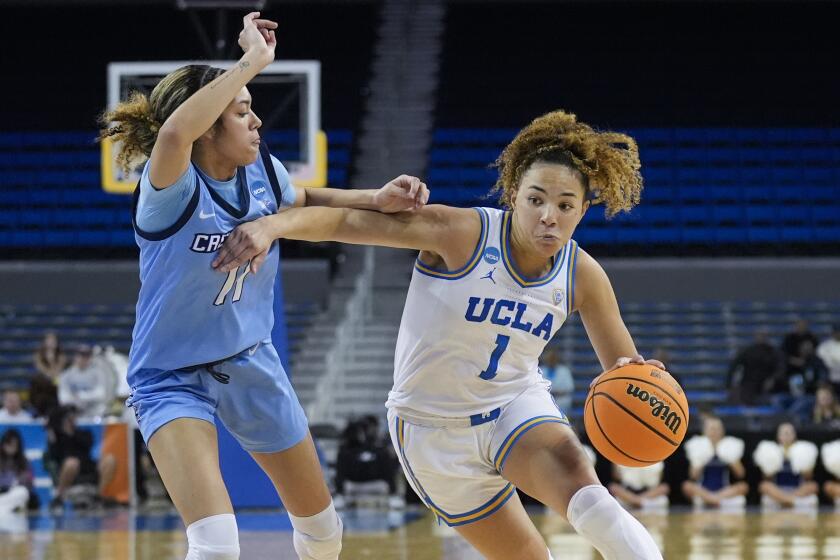
Kiki Rice’s scoring flurry rallies UCLA past Creighton and into the Sweet 16
Kiki Rice finishes with 24 points and Lauren Betts scores 20 as UCLA rallies to defeat Creighton and set up a showdown with LSU in the NCAA tournament.
March 25, 2024
They also won’t give in to easy narratives. Betts and Osborne disputed the notion that Reese lacked class, and they should know — they played with her for Team USA last summer.
“She’s an amazing teammate and I really enjoyed playing with her,” Betts said. “I think she’s an amazing person and obviously when it comes to basketball you’re trying to win, so it’s like, whatever you have to do to win, I don’t think that people should judge her for that.”
Said Osborne: “She’s really nice off the court as well and people don’t always see that.”
Everyone can see for themselves Saturday. How will the nation’s most polarizing team conduct itself versus the one known for its class? The reckoning is here.
Ben Bolch’s apology:
It has taken me two days to write this apology because I wanted to be as thoughtful as possible in my response to the situation I have created. These are words I have not been asked to write by anyone at my paper, but they need to be expressed so that I can own up to my mistake.
Words matter. As a journalist, no one should know this more than me. Yet I have failed miserably in my choice of words. In my column previewing the LSU-UCLA women’s basketball game, I tried to be clever in my phrasing about one team’s attitude, using alliteration while not understanding the deeply offensive connotation or associations. I also used metaphors that were not appropriate. Our society has had to deal with so many layers of misogyny, racism and negativity that I can now see why the words I used were wrong. It was not my intent to be hurtful, but I now understand that I terribly missed the mark.
I sincerely apologize to the LSU and UCLA basketball teams and to our readers. UCLA, a school I have covered for nearly a decade, champions diversity and is known as a leader in inclusivity. However, I have not upheld that standard in what I wrote and I will do much better. I am deeply sorry.
— Ben Bolch
More to Read
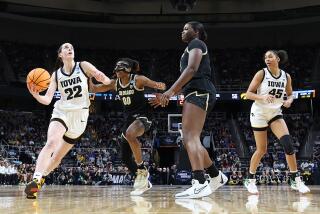
Granderson: Caitlin Clark is having a moment in women’s basketball. She shouldn’t be the only one
April 1, 2024
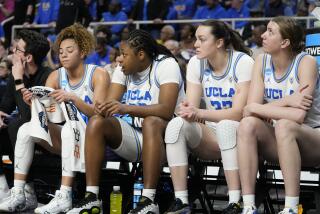
UCLA vows to turn disappointment into an elusive Final Four run next season
March 31, 2024
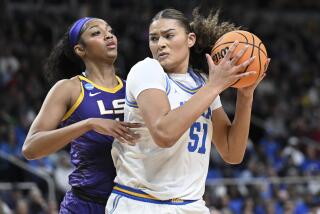
UCLA women falter at the finish in NCAA tournament loss to LSU
March 30, 2024
Go beyond the scoreboard
Get the latest on L.A.'s teams in the daily Sports Report newsletter.
You may occasionally receive promotional content from the Los Angeles Times.

Ben Bolch has been a Los Angeles Times staff writer since 1999. He is serving his second stint as the UCLA beat writer, which seems fitting since he has covered almost every sports beat except hockey and horse racing. Bolch is also the author of the recently released book “100 Things UCLA Fans Should Know & Do Before They Die.” He previously covered UCLA basketball from 2010-11 before going on to cover the NBA and the Clippers for five years. He happily traded in gobs of hotel points and airline miles to return to cover UCLA basketball and football in the summer of 2016. Bolch was once selected by NBA TV’s “The Starters” as the “Worst of the Week” after questioning their celebrity journalism-style questions at an NBA All-Star game and considers it one of his finer moments.
More From the Los Angeles Times
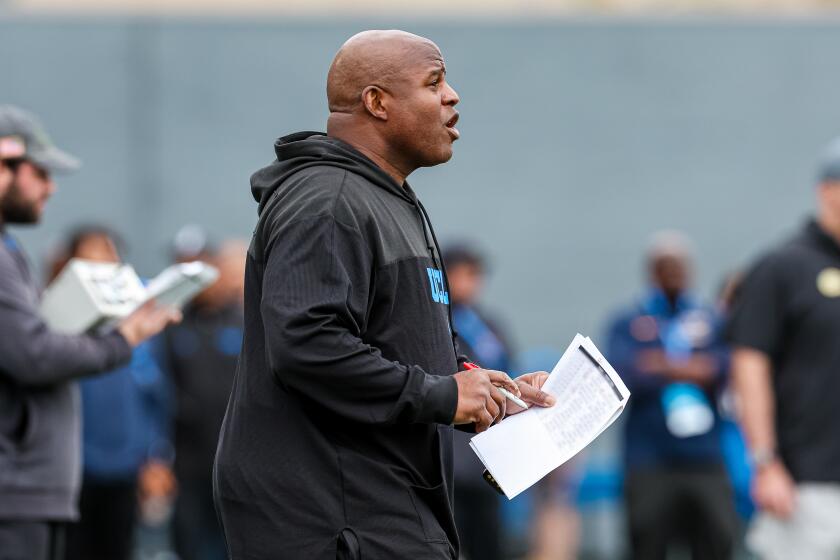
Eric Bieniemy taking a loud and collaborative approach to reshaping UCLA’s offense
April 4, 2024

USC guard Kobe Johnson is transferring to rival UCLA

Louisville guard Skyy Clark announces he is transferring to UCLA
April 3, 2024

UCLA opens spring football practice with an emphasis on welcoming fans
April 2, 2024

IMAGES
VIDEO
COMMENTS
What Is a Commentary Essay? (As a Separate Paper) A commentary essay is a written piece that provides an opinion on a particular subject. This type of essay is usually written in response to another piece, such as a blog post, article, or book passage.In a commentary essay, the writer will typically offer their own take on the situation, using evidence and examples to support their claims.
As a student writing a commentary essay, it is important to understand the differences between analyzing, summarizing, and evaluating. To help comprehend these contrasts, let's take a look at four main points: 1. Analyzing - Looking closely at something and breaking it down into smaller parts to better understand it.
First and foremost, a literary commentary is NOT an essay. The passage in front of you is not, therefore, an invitation to write a general essay about the work from which it has been taken. A commentary is an analysis of the given passage, its function and its characteristics. It should examine the key themes and stylistic devices of the ...
How to Write a Good Essay Part 1: Learn the Difference between Commentary and Summary. You need to understand the difference between commentary and summary. While both writing styles can be used to discuss another piece of work (like a play, book, movie, or poem), this is about the sum total of their similarities.
Make sure to use smooth transitions. When you move to a new example, use a good transition word or phrase. Some examples are "similarly", "conversely", and "again". 6. Write a strong conclusion. Your conclusion is the piece that will tie the rest of your commentary together. Make sure to include a summary of your argument.
The argumentative essay is a genre of writing that requires the student to investigate a topic, collect, generate, and evaluate evidence, and establish a position on the topic in a concise manner. Argumentative essay assignments generally call for extensive research of literature or previously published material.
Key Components of a Commentary Essay. 1. Introduction: Begin your essay with a captivating introduction that presents the topic and provides context for the reader. 2. Thesis Statement: Craft a clear and concise thesis statement that outlines your main argument or perspective. 3.
1️⃣ Step 1: Preparation. 2️⃣ Step 2: Stage Setup. 3️⃣ Step 3: Writing a First Draft of a Commentary Essay. 4️⃣ Step 4: Wrap-Up. 💡 20 Tips for Writing a Commentary Essay. 10 things to do when writing a commentary essay include: 10 things not to do include: 💭 Summing Up on How to Write a Perfect Commentary Essay.
2) Interpretation: your explanation of something that is not clear. 3) Character and Subject's Feelings: when you describe what the character or subject of the detail is feeling (ideal for literary analysis papers) 4) Personal Reaction: your personal emotions about the detail. 5) Evaluations: your objective judgment of a detail.
The commentary part of any essay is always the most difficult. It is the part of the essay in which the writer analyzes evidence, and this analysis speaks to the writer's own unique voice. While we have standard, formulaic ways to teach other parts of the essay such as thesis statements, blending quotes, topics sentences, etc., commentary is ...
Make a claim. Provide the grounds (evidence) for the claim. Explain the warrant (how the grounds support the claim) Discuss possible rebuttals to the claim, identifying the limits of the argument and showing that you have considered alternative perspectives. The Toulmin model is a common approach in academic essays.
Commentary Versus Opinion. This guide includes tips on writing common course assignments. In order to synthesize your sources, you must first analyze them to help provide rationale for why they are a part of your literature review and what role they play within your field. In order to demonstrate analysis, you must provide your commentary on ...
A commentary may also draw attention to current advances and speculate on future directions of a certain topic, and may include original data as well as state a personal opinion. While a commentary may be critical of an article published in the journal, it is important to maintain a respectful tone that is critical of ideas or conclusions but ...
Analysis—what we're calling commentary—is the student's opinion about the way evidence proves the truth of a topic sentence, which defends the truth of the controlling thesis statement. Here's how the connecting works. A rhetorical analysis essay has a thesis, which is a controlling idea. All ideas within the essay defend this one.
Structure of a perspective, opinion, or commentary article. A perspective, opinion, or commentary is based on ideas, opinions, and insights, and hence does not follow a strict structure like the IMRaD. As long as the ideas flow logically, the author is free to structure the article as he feels. Broadly, these articles have an introduction, a ...
It should be noted that there are two types of commentary essays: literary and data. Literary commentary is an in-depth analysis of a passage of a literary work or text. Whereas data commentary is a piece of writing that comments on a visual display. Its main purpose is the interpretation of a research paper. Commentary Essay Writing Algorithm ...
Writing commentary is undoubtedly the most difficult part of writing any essay. All other parts of the essay are more formulaic in nature. There are standard rules for how to write a thesis statement, a topic sentence, a blended quotation, etc. But when it comes to commenting on evidence, there isn't one set way to do it.
In summary, a commentary may be: 1. A critical challenge to one or more aspects of. the focal article, arguing for a position other. than that taken in the focal article. 2. An elaboration or ...
In order to effectively write commentary in your body paragraphs, you need to have an understanding of the rhetorical situation. The rhetorical situation includes the following elements: the writer or speaker, the audience, the (historical) context, the exigence (ie. what prompted the writer to write), the purpose, and the message or argument.
Revised on July 23, 2023. An essay outline is a way of planning the structure of your essay before you start writing. It involves writing quick summary sentences or phrases for every point you will cover in each paragraph, giving you a picture of how your argument will unfold. You'll sometimes be asked to submit an essay outline as a separate ...
A perspective "piece" is a personal opinion in writing that is a review of a certain topic. Usually, these are short essays that are intended to review concepts in a particular field based on writer's own assessment. For instance, Nature often publishes peer-reviewed essays that discuss research models and concepts to help raise awareness ...
Commentary can be found in various forms, such as essays, articles, and reviews, and is typically written by experts or professionals in a particular field. ... Commentary is a detailed analysis or explanation of a topic. Using comment instead of commentary can lead to confusion and misinterpretation. By being mindful of these differences ...
commentary: [noun] an explanatory treatise. a record of events usually written by a participant.
Commentary: UCLA-LSU is America's sweethearts vs. its basketball villains. LSU coach Kim Mulkey crouches down and watches from the sideline during an NCAA tournament game against Middle ...